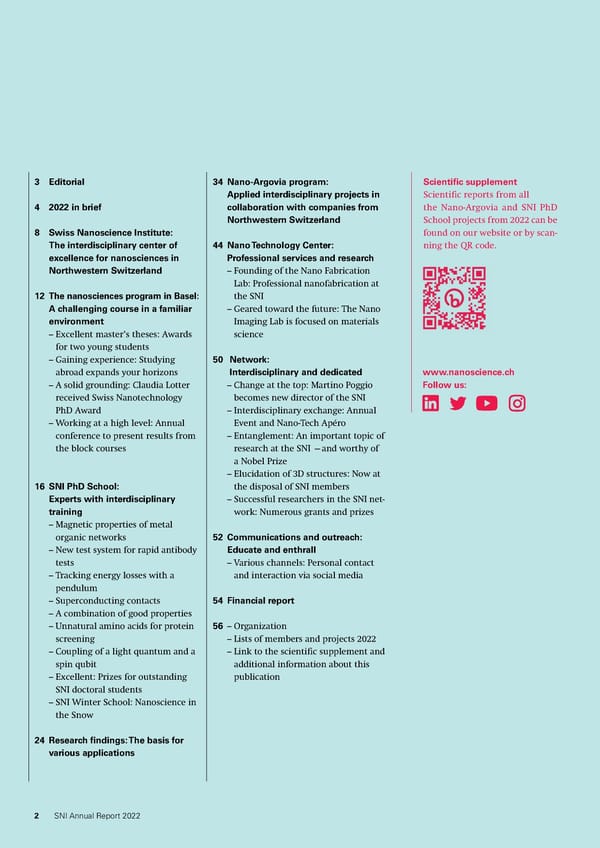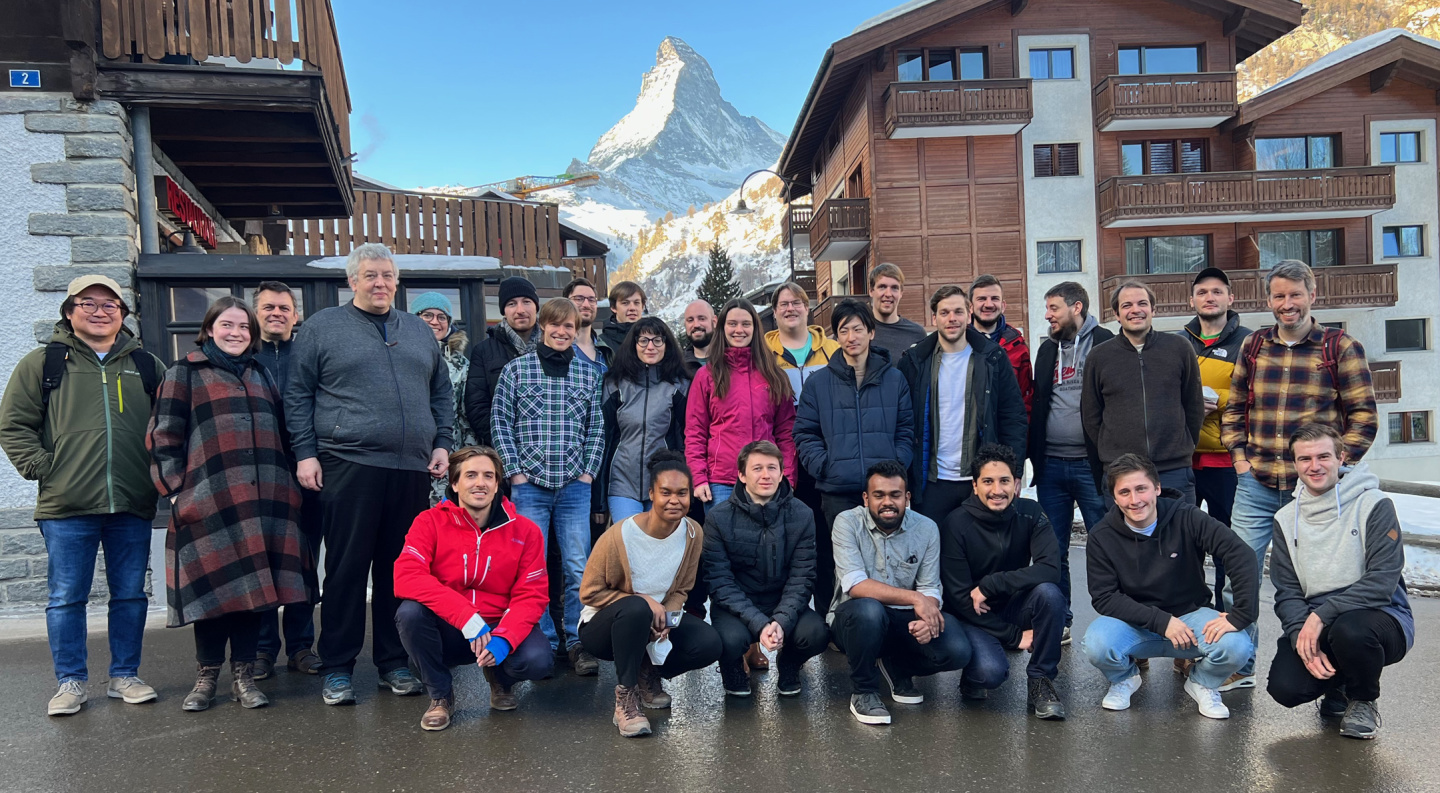SNI Annual Report 2022
We describe results and activties of the SNI network in 2022 and provide key numbers.
Annual Report 2022 Swiss Nanoscience Institute
3 Editorial 34 Nano-Argovia program: Scientific supplement Applied interdisciplinary projects in Scientific reports from all 4 2022 in brief collaboration with companies from the Nano-Argovia and SNI PhD Northwestern Switzerland School projects from 2022 can be 8 Swiss Nanoscience Institute: found on our website or by scan- The interdisciplinary center of 44 Nano Technology Center: ning the QR code. excellence for nanosciences in Professional services and research Northwestern Switzerland – Founding of the Nano Fabrication Lab: Professional nanofabrication at 12 The nanosciences program in Basel: the SNI A challenging course in a familiar – Geared toward the future: The Nano environment Imaging Lab is focused on materials – Excellent master’s theses: Awards science for two young students – Gaining experience: Studying 50 Network: abroad expands your horizons Interdisciplinary and dedicated www.nanoscience.ch – A solid grounding: Claudia Lotter – Change at the top: Martino Poggio Follow us: received Swiss Nanotechnology becomes new director of the SNI PhD Award – Interdisciplinary exchange: Annual – Working at a high level: Annual Event and Nano-Tech Apéro conference to present results from – Entanglement: An important topic of the block courses research at the SNI —and worthy of a Nobel Prize – Elucidation of 3D structures: Now at 16 SNI PhD School: the disposal of SNI members Experts with interdisciplinary – Successful researchers in the SNI net- training work: Numerous grants and prizes – Magnetic properties of metal organic networks 52 Communications and outreach: – New test system for rapid antibody Educate and enthrall tests – Various channels: Personal contact – Tracking energy losses with a and interaction via social media pendulum – Superconducting contacts 54 Financial report – A combination of good properties – Unnatural amino acids for protein 56 – Organization screening – Lists of members and projects 2022 – Coupling of a light quantum and a – Link to the scientific supplement and spin qubit additional information about this – Excellent: Prizes for outstanding publication SNI doctoral students – SNI Winter School: Nanoscience in the Snow 24 Research findings: The basis for various applications 2 SNI Annual Report 2022
Dear colleagues and interested parties, This annual report looks back on another Other key areas of the SNI’s work include For us, as an interdisciplinary network eventful year. After two years of the coro- basic scientific and applied research as with colleagues at different research in- navirus pandemic, we were able to re- well as the training of excellent scientists stitutions, it was also important that we sume our work in the lab with almost no — and this will continue to be the case in were able to meet in person again and restrictions and return to meeting up the future. exchange ideas at the Annual Event and again in person. Although virtual formats It’s now been 20 years since the first the Nano-Tech Apéro in 2022. It is pre- helped us to stay in touch during the pan- students began their bachelor’s degrees cisely at events like these that new ideas demic, it has become clear to us all that in nanosciences at the University of Basel emerge for innovative interdisciplinary they cannot replace personal interactions and 10 years since we advertised the first projects that reach across institutional altogether. projects at the SNI PhD School. Since boundaries, and these projects are what Among other things, we used the first then, many young researchers have com- makes the Swiss Nanoscience Institute so half of the year to prepare for a change in pleted their training here in Basel and special. leadership at the Swiss Nanoscience Insti- embarked upon careers in industry and I hope this report provides you with tute. For 16 years, Christian Schönen- at universities. In this annual report, we some entertaining and interesting in- berger led the SNI as its director, building look at some of the highlights of the sights into the SNI’s work in 2022, and I it up into what is now – a recognized cen- course of studies and the PhD School. look forward to working together again ter of excellence for the nanosciences and We also outline findings of research this year. nanotechnology. I myself owe a great deal carried out within the network and des- to this network, having been part of it as cribe applied research projects that were Kind regards, an Argovia Professor since 2009. As SNI funded in collaboration with industrial Director since August 2022, I now have companies from the Canton of Aargau or the opportunity to give something back one of the Basel half cantons as part of and to help shape the future of this unique the Nano-Argovia program in 2022. Our network. I’m supported in these efforts by new approach whereby these findings are the newly constituted SNI Executive Com- reported only briefly in this general sec- Professor Martino Poggio mittee, whose members represent the tion of the annual report, while the sci- SNI Director SNI’s network partners, as well as the par- entific supplement explores them in ticipating departments at the University greater depth, has proven successful. of Basel, and have also assumed leader- In the second half of 2022 especially, ship of areas such as the Nano-Argovia numerous events served as an opportu- program, the nanoscience curriculum and nity for the SNI team to attract public in- the newly founded Nano Technology Cen- terest in the nanosciences, the SNI in gen- ter. Together, we will continue to expand eral and the nanosciences degree course the SNI and ensure it is well equipped for at the University of Basel. In this regard, a future in which nanotechnologies are I would particularly like to highlight our set to play an increasingly key role. excellent collaboration with Museum In 2022, we took an important step in Burghalde in Lenzburg, which allows us this direction by founding the Nano Tech- to inform broad sections of the general nology Center, which includes the al- public about the Canton of Aargau’s com- ready established Nano Imaging Lab and mitment to the nanosciences. Another the newly founded Nano Fabrication Lab. highlight of our outreach work in 2022 The staff of these two service units offer was the SNI’s attendance at the Rüe- valuable services to customers from aca- blimärt in Aarau, where we were able to demia and industry, as well as making give the many keen visitors there insights valuable contributions to various lines of into the rich possibilities that the nano- research. sciences offer. SNI Annual Report 2022 3
2022 in brief Two prizewinning master’s theses In 2022, the two former nanoscience stu- dents Vera Weibel and Mathias Claus re- ceived prizes for their outstanding mas- ter’s theses. Vera Weibel investigated a superconducting material and Mathias Claus developed a torsion rocker. Page 13 Studying at renowned universities abroad Nanoscience students again had the op- portunity to complete part of their master’s studies abroad in 2022. Four students took up Argovia Travel Grants in order to fulfil their dreams of study- ing in the USA or Australia. The stu- dents wrote their master’s theses at various renowned universities and took this unique opportunity to get to know other cultures and to begin building their international network. Page 14 Swiss Nanotechnology PhD Award for young researchers from the SNI network Former nanoscience student Claudia Lotter and former SNI doctoral student Dr. A short video Informal conference for doctoral students Thomas Mortelmans received the Swiss summarizes The year 2022 also saw the return of the “Nanoscience in the Nanotechnology PhD Award. In her mas- some key figures Snow” Winter School for doctoral students at the SNI. Sur- ter’s thesis, Claudia Lotter investigated and activities of rounded by breathtaking scenery in Zermatt, the young scien- how lipid nanoparticles developed for gene the SNI in 2022. tists used the time to exchange ideas about their wide-ranging therapy can be optimized by tweaking the research projects and to get to know each other better. lipid composition. In his doctoral disserta- Page 21 tion at the SNI PhD School, Thomas Mor- telmans built a new platform for antibody Varied topics tests. In 2022, seven doctoral students successfully completed their Pages 14 and 20 doctoral dissertations at the SNI PhD School, having carried out the corresponding practical work at the Department of Physics and the Biozentrum at the University of Basel and at the Paul Scherrer Institute. From page 17 4 SNI Annual Report 2022
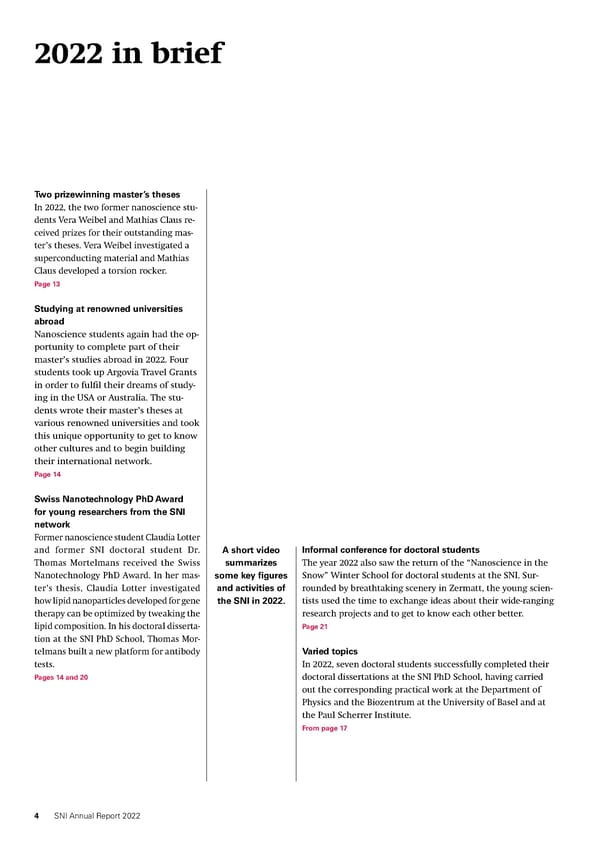
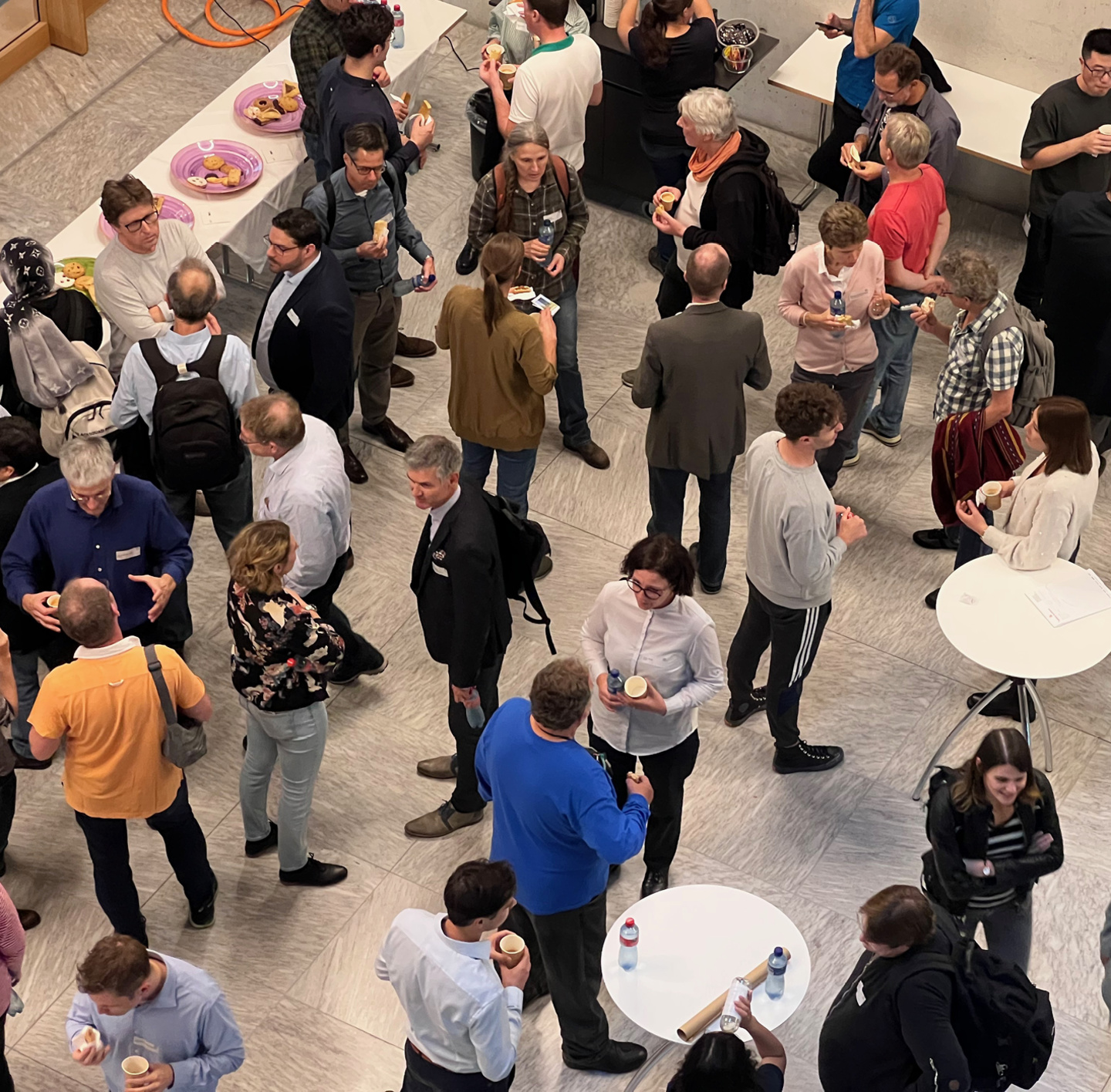
Former SNI doctoral student Former SNI doctoral student Former SNI doctoral student Thomas Mortelmans won one of Alexina Ollier received a Young Thomas Karg won an SPS Award. the Swiss Nanotechnology Researcher Award. PhD Awards. Detecting coronavirus and flu Cooling matter from a distance Researchers from the University of Basel Researchers from the University of Basel have used laser light and the Paul Scherrer Institute have de- to form a control loop consisting of two quantum systems sep- veloped a rapid test for Covid-19 based on arated by a distance of one meter. Within this loop, a vibrating a novel functional principle. The test membrane is cooled by a cloud of atoms. Interfaces of this could be used to determine the status of kind will play a role in future quantum technologies. the disease or to detect other diseases Page 27 and different variants of Covid-19. Page 25 Floating thanks to sound waves Sound waves can be used to keep tiny rotating sample holders New approach to biosensor floating in mid-air — for example, for crystallographic analyses. technology Researchers from the SNI network have shown how this effect Researchers from the SNI network have is influenced by the size and shape of the rotors. developed a new coating — made of a Spin filters can Page 31 polymer and carbon nanotubes — that is be used to suitable for coating miniaturized elec- demonstrate a Dancing molecules trodes. Electrodes of this kind feature negative correla- Cycloalkanes adapt their shape if they are enclosed in tiny pores. conductive nanomaterials embedded in tion between the In response to an increasing lack of space and at low tempera- a repellent matrix and have applications two spins of an tures below 5K, the molecules start to move in a surprising way. in point-of-care laboratory diagnostics. entangled elec- Page 27 Page 25 tron pair from a superconductor. Time-saving due to early diagnosis (Image: SNI/ Nanomechanical sensors are ideally suited Scixel) to quickly and reliably detect even a few bacteria in the blood. Seite 25 SNI Annual Report 2022 5
6 SNI Annual Report 2022
The best of both worlds Basic and applied research are key pillars of the SNI’s work. Whereas the SNI PhD School primarily deals with questions of basic science, the Nano-Argovia pro- gram is all about applied projects. Here, researchers from the SNI network work closely with industrial companies from Northwestern Switzerland and support the process of knowledge and technology transfer. More information from page 34 onward. Working with vVardis (formerly credentis), research- ers from the FHNW School of Life Sciences treated the surfaces of teeth with fluoride paste and ex- posed them to artificial saliva. (Image: L. Kind, FHNW) SNI Annual Report 2022 7
Swiss Nanoscience Institute: The interdisciplinary center of excellence for nanosciences in Northwestern Switzerland The Swiss Nanoscience Institute (SNI) at the Uni- versity of Basel is a center of excellence for nano- sciences and nanotechnology, founded in 2006 on 20% the initiative of the Canton of Aargau and the Uni- versity of Basel. 20% of SNI members are women. In the SNI network, interdisciplinary teams of sci- entists conduct basic and applied research. More- over, the SNI actively supports knowledge and technology transfer to industrial companies from Northwestern Switzerland through the Nano-Argo- via program and is a founding member of the 4+8+7 ANAXAM technology transfer center. In 2022, 4 students successfully completed their bachelor’s program, 8 completed Two SNI service units — the Nano Imaging Lab and the master’s program. the Nano Fabrication Lab — provide researchers Seven PhD students successfully from academia and industry with services relating defended their PhD theses. to imaging and analysis, as well as nano and micro fabrication, and also support research projects. The SNI offers not only a bachelor’s and master’s degree program but also a PhD School, providing interdisciplinary training to early career research- ers. Finally, the SNI also engages in public rela- tions work with a view to generating interest in 40 the natural sciences among various target groups In 2022, 40 PhD students were enrolled and supporting collaboration between academia in the SNI PhD School. and industry. 8 SNI Annual Report 2022
166 166 members belong to the SNI network. 9 (PIs, PhD students, management, Nano There are nine partner institutions in Fabrication Lab, and Nano Imaging Lab) the SNI network. These include the research institutions University of Basel, the School of Life Sciences and the School of Engineering at the University of Applied Sciences and Arts Northwestern Switzerland (FHNW), the Paul Scherrer Institute PSI, the Cen- 15 tre Suisse d`Electronique et de Micro- Fifteen of the 48 PhD students technique (CSEM) in Allschwil, the who had completed their PhDs Department of Biosystems Science and by the end of 2022 work at a federal or Engineering at the ETH Zurich in Basel, research institution. and the technology transfer center 48 ANAXAM. The network also includes The SNI supported financially the Hightech Zentrum Aargau and 48 research projects, 12 in the applied Basel Area Business & Innovation. Nano-Argovia Programm and 36 in the SNI PhD School. 33 Thirty-three of the 48 PhD students who had completed their PhDs by the end of 2022 work in industry. 8.08 M 84 In 2022, the SNI had expenditures of In 2021, 59 students were enrolled approximately CHF 8.08 million (without on the bachelor’s program and 25 building costs) of which CHF 5.14 million on the master’s program. were covered by the Canton of Aargau and CHF 2.94 million by the 44 University of Basel. In 2022, a total of 44 peer-reviewed 77+120 papers with participation of SNI Since its foundation in August 2022, the members were published in renowned Nano Fabrication Lab had 77 users. science journals. In 2022, the Nano Imaging Lab received more than 175 orders, which often >4300 take several days, from 120 different The SNI social media channels on customers. Instagramm, LinkedIn, Twitter and You- Tube have more than 4,300 followers. SNI Annual Report 2022 9
The SNI devel- Commitment from the Canton of Aargau and program in nanosciences. At the end of 2022, there oped from the the University of Basel were 59 students enrolled on the bachelor’s program National Center of The SNI was founded in 2006 by the Canton of Aargau and 25 early career researchers enrolled on the mas- Competence in and the University of Basel in order to drive forward ter’s program. Research “Nano- research and training in the nanosciences and nano- Some students on the nanoscience program then scale Science” on technology in Northwestern Switzerland. Nanotech- continue their training at the SNI PhD School, which the initiative of nologies play a key role in research and industry in was founded in 2012, although most of the 40 doc- the Canton of the Canton of Aargau and are one of the focal areas toral students enrolled in the PhD School in 2022 Aargau and the of the Hightech Aargau innovation-support program, came from other universities in Europe, Asia or University of with which the Canton seeks to bolster not only the America. The PhD School also provides young re- Basel. competitiveness of companies but also value cre- searchers with insights into subjects outside of their ation. Researchers from various disciplines and in- own area of research. In particular, this interdisci- stitutions work together on numerous successful SNI plinarity is further enhanced at events such as the research projects, which support this strategy in the “Nanoscience in the Snow” Winter School, the An- Canton of Aargau and provide companies from Aar- nual Meeting and various courses developed specif- gau, Solothurn and the two Basel half cantons with ically for the PhD School. In 2022, seven doctoral access to new scientific findings and technologies. students successfully completed their doctoral dis- In 2022, the SNI spent approximately 8.08 million sertations at the SNI PhD School, bringing the total Swiss francs, of which some 5.14 million were pro- number to 48. A further seven new projects were vided by the Canton of Aargau and 2.94 million by approved and will begin in 2023. the University of Basel. Leaders in their field Its success is An interdisciplinary and agile network Basic sciences are the foundation of research work based on an The Swiss Nanoscience Institute is a network of re- at the SNI. As well as the various projects funded as ever-expanding searchers from various disciplines who participate part of the PhD School, the SNI also supports basic interdisciplinary in basic scientific or applied research projects. Par- scientific research carried out by the two Argovia network of ticipating researchers come from the leading scien- Professors Roderick Lim and Martino Poggio, whose committed tific institutions of Northwestern Switzerland, in- work contributes to the SNI’s outstanding interna- researchers. cluding the Departments of Biomedicine, Chemistry, tional reputation. Environmental Sciences, Pharmaceutical Sciences, In addition to the Argovia professors, the SNI Physics, and the Biozentrum of the University of Ba- supports three titular professors: Professor Thomas sel, the Schools of Life Sciences and Engineering at Jung teaches and researches at the Department of the University of Applied Sciences Northwestern Physics of the University of Basel and leads another Switzerland (FHNW) in Muttenz and Windisch, the team at the Paul Scherrer Institute PSI. Professors Paul Scherrer Institute PSI, the Department of Bio- Frithjof Nolting and Michel Kenzelmann also lecture systems Science and Engineering at the Federal In- at the Department of Physics and are active with stitute of Technology (ETH) Zurich in Basel (D-BSSE), their research groups at the PSI. the CSEM (Centre Suisse d’Electronique et de Micro- technique) in Allschwil and the ANAXAM technology Knowledge and technology transfer to industry transfer center. Collaborations are also underway The SNI supports the transfer of scientific findings with the Hightech Zentrum Aargau in Brugg and Ba- to industry through the Nano-Argovia program, sel Area Business & Innovation in the area of knowl- which has been promoting collaboration between edge and technology transfer. companies from Northwestern Switzerland and re- search institutions since the SNI was founded. In One key objective Excellent early career researchers total, 12 of these applied research projects were of the SNI is to The SNI’s precursor institution set up a bachelor’s funded in 2022. Half of the partner companies came train outstanding and master’s program in nanosciences at the Univer- from the Canton of Aargau, while the other half scientists. sity of Basel 20 years ago. Students on the bachelor’s came from one of the two Basel half cantons. Col- program are first given a solid grounding in biology, laboration with industry is also supported by the chemistry, physics and mathematics and can then new ANAXAM technology transfer center, of which choose more courses that suit their personal inter- the SNI is a founding member. ANAXAM provides ests as they progress through this demanding pro- companies throughout Switzerland with access to gram. They have the opportunity to participate in state-of-the-art analytical methods. various research groups and gain insights into ap- plied projects in industry at an early stage in their Expanded range of services education. So far, a total of 273 students have earned The SNI is also on hand as a provider of various ser- a bachelor’s degree in nanosciences at Basel, and 211 vices to partners in academia and industry. As part students have successfully completed the master’s of the SNI since 2016, the Nano Imaging Lab (NI Lab) 10 SNI Annual Report 2022
Department of Chemistry Biozentrum Department of Department of Physics Environmental CSEM Sciences University of Basel Allschwil SNI Nano Fabrication Lab Department of Nano Imaging Lab Biomedicine Department of Pharmaceutical FHNW School of Sciences LIfe Sciences FHNW School of Engineering D-BSSE ETHZ Basel Paul Scherrer Institute PSI ANAXAM The interdisciplinary network of the SNI is made up of research groups from the leading research institutions in Northwestern Switzerland. These research groups work on basic scientific and ap- plied projects and ensure an excellent standard of research work. (Image: iStock) The Nano- has a six-person team and offers comprehensive ser- ence festivals and exhibitions and provides school Argovia program vices relating to surface imaging and analysis. In classes and groups of interested visitors with insights supports knowl- 2022, a second service unit was added in the form of into everyday laboratory life. The SNI also collates edge and tech- the Nano Fabrication Lab (NF Lab), which brought information in the form of videos, brochures, press nology transfer. together existing activities and infrastructure from releases and an online magazine. News on research the Department of Physics in order to offer profes- findings, events and awards is shared via various so- sional and effective services in the promising area cial media channels, thereby reaching different tar- of nanofabrication. get groups. The Nano Imag- Fostering an interest in the natural sciences ing Lab and Nano It’s important to the SNI team not only to train ex- Fabrication Lab cellent scientists, conduct excellent research and act service units as a sought-after partner and service provider, but assist researchers also to inform the general public about its various with various activities and foster an interest in the natural sci- questions. ences. For example, the SNI team takes part in sci- SNI Annual Report 2022 11
The nanosciences program in Basel: A challenging course in a familiar environment The nanosciences program at the University of Basel boasts a high degree of interdisciplinarity as well as excellent supervision and a strong team spirit amongst students. Across Switzerland, Basel is the only university to offer a bachelor’s and master’s degree program in nanosciences. As part of the bache- lor’s program, students receive a broad grounding in biology, chemis- try, physics and mathematics as well as an insight into the scientific work of various research groups and industrial companies. Students on the master’s program choose two subjects from the available spe- cializations — chemistry, medical nanosciences, molecular biology and physics — in which they then complete two projects and a mas- ter’s thesis. At the end of 2022, there were 59 students enrolled on the bache- lor’s program and 25 on the master’s program. Four students suc- cessfully completed the bachelor’s program, and eight completed their studies with a master’s degree. 12 SNI Annual Report 2022
Nanoscience students at the University of Basel support one another. (Image: F. Moritz) Excellent master’s theses Awards for two young students In 2022, Vera Weibel and Mathias Claus were awarded a prize for the best mas- ter’s thesis in nanosciences from the Uni- versity of Basel. Vera Weibel Mathias Claus In her prizewinning thesis, which she wrote at EPFL, Vera Weibel studied a su- perconducting material that does not oc- cur in nature and that features highly “Mathias initially began work- unusual properties. ing on an idea for the ideal For his master’s thesis at the Depart- “What particularly impressed magnetic torque sensor at the ment of Physics of the University of Basel, me about Vera Weibel’s work nanoscale. Over the course of Mathias Claus developed a torsion rocker was the amazing agreement his project, he developed a that can be used to study the magnetiza- between the theoretical predic- state-of-the-art fabrication pro- tion of tiny magnets in precise detail. tions and the experiment.” cess and, after testing the sen- Report about Vera Weibel: Professor Christian sor, showed that it actually out- http://bit.ly/3RRsL1r Schönenberger, performs some of the previ- Report about Mathias Claus: http://bit.ly/3S1mlwU Department of Physics, ously used sensors.” Video: https://youtu.be/DyoPupfgaMs University of Basel Professor Martino Poggio Department of Physics, University of Basel SNI Annual Report 2022 13
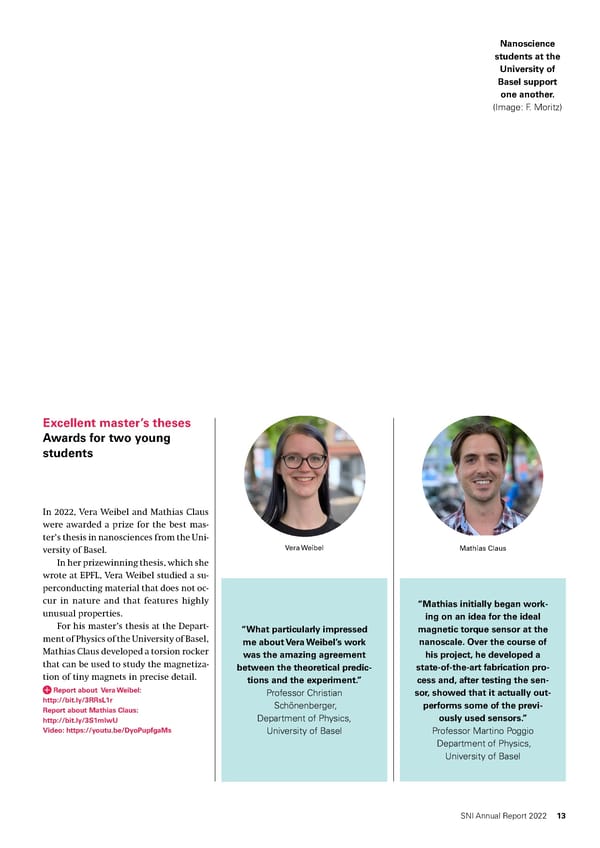
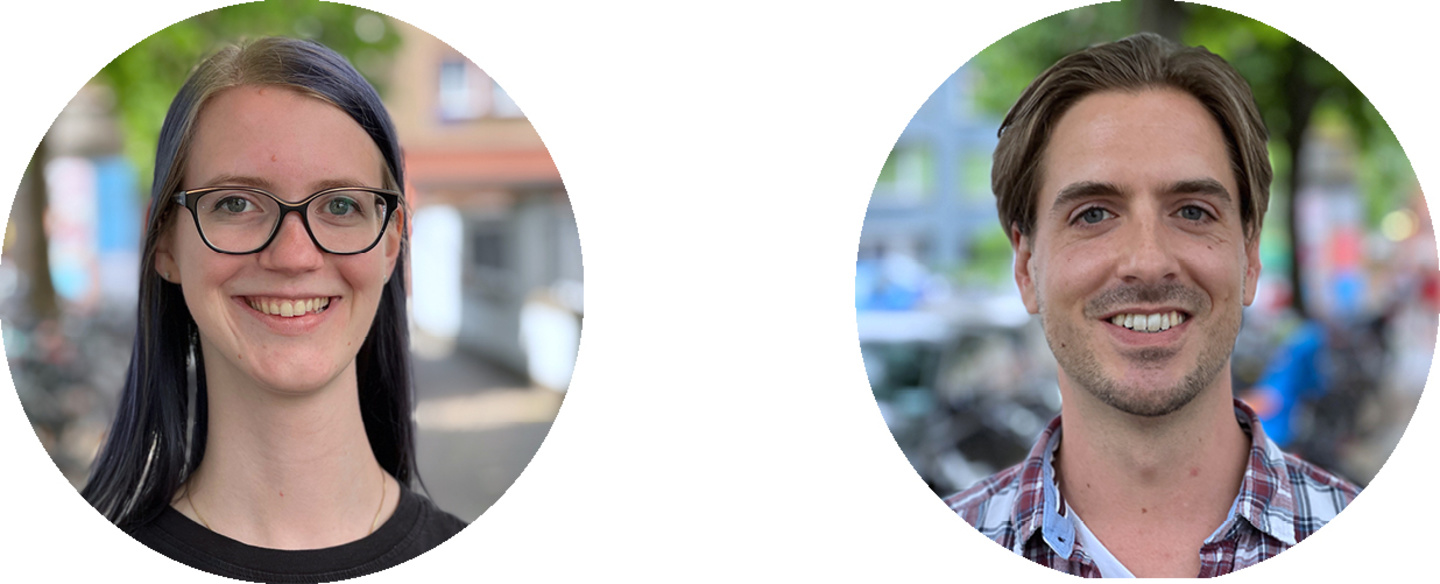
Gaining experience A solid grounding Studying abroad expands Claudia Lotter received your horizons Swiss Nanotechnology PhD Award During their master’s studies, numerous students on the nanoscience program gain As part of her master’s thesis at Basel Uni- experience abroad and apply for financial versity’s Department of Pharmaceutical aid in the form of Argovia Travel Grants. Sciences, former nanoscience student Due to the coronavirus pandemic, how- Claudia Lotter investigated how lipid ever, many students were unable to go nanoparticles developed for gene therapy ahead with their plans to study abroad. can be optimized by varying the lipid In 2022, a degree of normality re- composition. turned, allowing students to complete She completed this work in the first their master’s theses at international uni- year of her doctoral dissertation and pub- versities and receive financial aid through lished the results in the European Journal the Argovia Travel Grant program. of Pharmaceutics and Biopharmaceutics. Milan Liepelt wrote his master’s thesis In recognition of this publication, Claudia in the field of quantum biology at the Uni- was awarded a Swiss Nanotechnology PhD versity of California, Los Angeles (USA). Award sponsored by the Hightech Zen- Philippe van der Stappen went to Monash trum Aargau at the Swiss NanoConven- University in Melbourne (Australia) to tion in summer 2022. study regions of the cell that are respon- Report: http://bit.ly/3HSdh8V sible for cellular movement. As part of her master’s thesis at the University of California, San Francisco (USA), Tamara Utzinger is studying immune cells that can cross the blood-brain barrier and trig- ger inflammation in the event of neuro- degenerative diseases in the brain. Lastly, through his research at Harvard Univer- sity (USA), Nicolai Jung contributed to the development of vaccines against malaria parasites. Mobility nanoscience program: http://bit.ly/3Jss64m Report about Nicolai Jung: http://bit.ly/3luCiQ2 “I would recommend that all students do the same and spend some time abroad. It might involve some extra work at first, but it’s definitely worthwhile!” Nicolai Jung former nanoscience student and now research assistent at the Walter and Eliza Hall Institute of Medical Research in Melbourne At the Swiss NanoConvention 2022, Claudia Lotter (Australia) was presented with a Swiss Nanotechnology PhD Award by Marcus Morstein (Hightech Zentrum Aargau). (Image: T. Byrne) 14 SNI Annual Report 2022
The master’s degree ceremony is the grand finale of the nanosciences degree program. (Image: K. Schad) Working at a high level Annual conference to present results from the block courses In the fifth and sixth semesters of the bachelor’s program, na- noscience students complete eight block courses. As part of these highly popular internships, the students work on their own small projects in various research groups. Here, they learn about scientific work based on current research and make new contacts. The courses are an ideal opportunity for them to ex- plore their interests in greater depth so that they can then choose two specializations for the master’s program. Results from the block courses are presented by the students at a conference known as SmallTalk, which is organized by the students themselves. Here, each student gives a talk and pres- ents another topic in the form of a poster for an interdisciplin- ary audience comprising researchers from the University of Talking to researchers from the SNI network, Daniel Gaus ex- Basel. plains his experiments in relation to a bacterial nanoharpoon, which he carried out as part of a block course at the Biozentrum. SNI Annual Report 2022 15
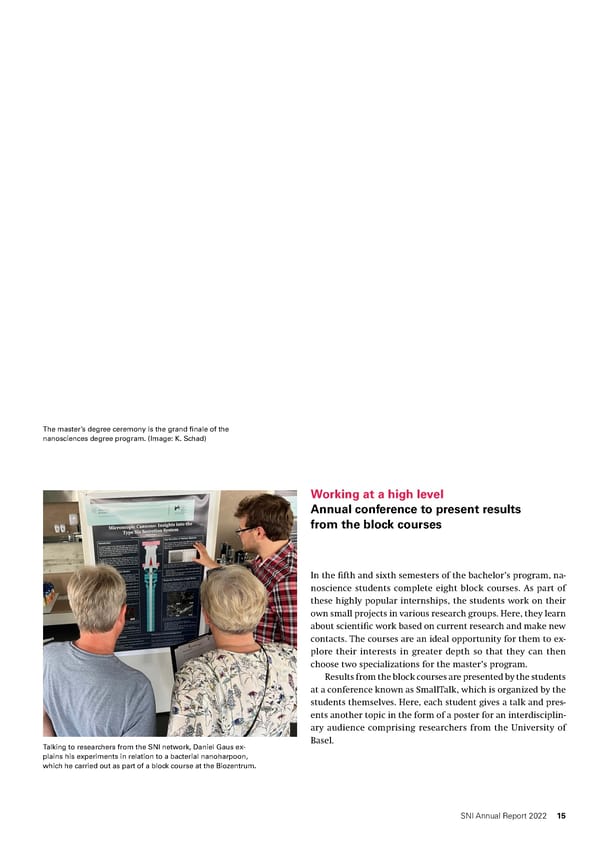
SNI PhD School: Experts with interdisciplinary training Doctoral students at the SNI PhD School carry out their work at various departments of the University of Basel, the Paul Scherrer Institute, the University of Applied Sciences Northwestern Switzerland or the Depart- ment of Biosystems Science and Engineering of ETH Zurich in Basel. In their various working groups, they research current problems in the nanosciences and are trained as specialists in a wide range of fields. As these doctoral students also attend joint SNI events, they benefit from regular interaction with researchers from other disciplines and gain a broad overview of numerous current research projects in the nanosciences and nanotechnology. Moreover, in courses developed specially for the SNI PhD School, the young scientists learn to present their work professionally and familiar- ize themselves with the initial steps involved in founding a startup. At the end of 2022, there were 40 doctoral students enrolled in the SNI PhD School of whom 25% percent are women. Seven doctoral stu- dents have successfully completed their dissertations and seven new dissertation projects are set to begin in 2023. Of the 48 SNI doctoral students who have completed their dissertations so far, 69% are employed in industry, while 31% continue to pursue an academic career. 16 SNI Annual Report 2022
Mehdi Heydari conducted research for his doctor- During his doctorate, Thomas Mortelmans Alexina Ollier wrote her doctoral thesis at the De- al thesis at the Paul Scherrer Institute. worked at the Paul Scherrer Institute. He is now partment of Physics at the University of Basel. employed as a StepIn Trainee at the healthcare She is currently working there as a postdoc until organization Johnson & Johnson. she will start a postdoc position in South Korea at the Center for Quantum Nanoscience. Magnetic properties New test system for rapid Tracking energy losses of metal organic networks antibody tests with a pendulum For his doctoral thesis, Dr. Mehdi Heydari For his doctoral thesis, Dr. Thomas Mor- For her doctoral thesis, Dr. Alexina Ollier synthesized and subsequently character- telmans developed a novel test principle investigated energy losses and quantum ized various metal organic networks with for rapid antibody tests. He used the new effects in two-dimensional materials. To rare and exotic physical properties on system to detect antibodies against SARS- do this, she worked with a special atomic surfaces. CoV-2 and influenza A viruses in blood force microscope (AFM) whose cantilever Metal organic networks are porous samples. acts as a tiny pendulum that swings back sheets that are built up by connecting or- Unlike other rapid tests, which detect and forth and can indirectly measure en- ganic molecules via inorganic atoms. The specific virus components, the test devel- ergy losses during current flow. self-assembly and structure of these net- oped by Thomas Mortelmans reacts to Alexina studied single-layer graphene works are determined by the choice of antibodies formed by patients against the as well as molybdenum disulfide and linker atoms and their coordination virus. The test involves mixing a blood graphene bilayers, which have special chemistry — in conjunction with the re- sample with nanoparticles that bind to electrical properties when one layer is active ends or functional groups of the specific structures on the antibody sur- twisted at a magic angle relative to the molecules. In addition to the structure, face. Other additives in the form of fluo- other. She was able to show that the three the choice of components also has a de- rescent particles bind specifically to the different 2D materials differ greatly in cisive impact on the magnetic and elec- patients’ antibodies. The blood sample terms of energy loss and their quantum trical properties. prepared in this way is then dripped onto mechanical effects. After synthesizing several of these a Plexiglas chip into which nanochannels The free-floating single-layer graphene metal organic networks, Mehdi Heydari have been etched in a sophisticated pat- behaved similarly to quantum dots. In the showed that the magnetism typically ob- tern. During their passage through the twisted graphene bilayer, Alexina ob- served in such networks is annihilated in nanochannels, which takes place without served oscillations in the energy losses as those with triangular connectivity in a technical aids, the antibody-nanoparticle a function of the external magnetic field phenomenon referred to as “frustration” aggregates become trapped at particu- — probably as a result of quantum me- of a physical system. Frustrated metal or- larly narrow sites that correspond to the chanical interference effects. In an atomic ganic networks serve as interesting mod- size of the nanoparticles. Thanks to the layer of molybdenum disulfide, she de- els for the complex behavior of systems fluorescent appendages, this can be ob- tected a phase transition between ferro- exhibiting statistical fluctuation, such as served under the microscope. magnetism and paramagnetism. spin glasses. Coordination chemistry of- The system can be adapted to antibod- Video: https://youtu.be/gzlXDVMMDd0 fers a unique opportunity to design novel ies against all kinds of viruses and pro- Report in SNI INSight: http://bit.ly/3lv3Tk7 low-dimensional materials with a view to vides not only sensitive detection of an technological developments in spintron- infection, but also information about the ics and quantum information technology. immune system’s response based on dif- ferent signal strengths. Publication: https://bit.ly/40hHmH9 Video: https://youtu.be/7VKskNZCoMc SNI Annual Report 2022 17
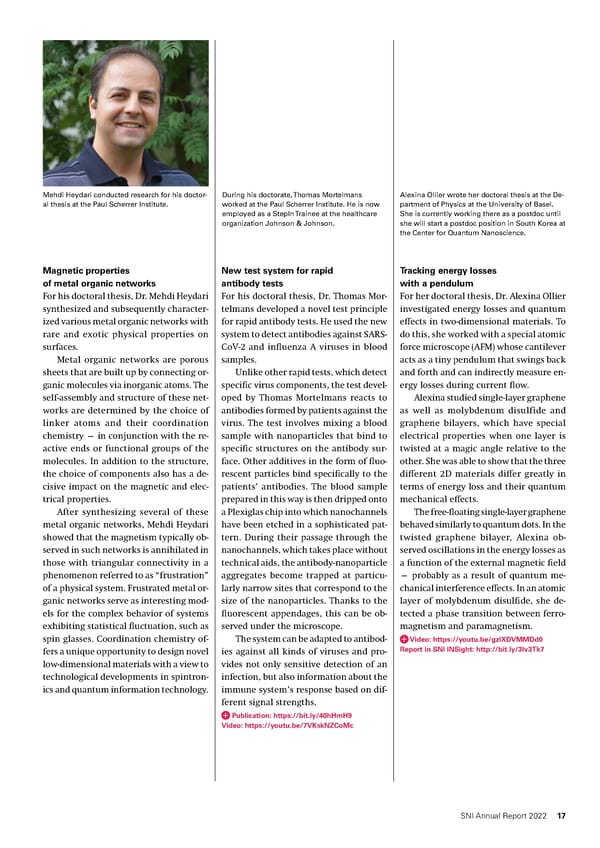
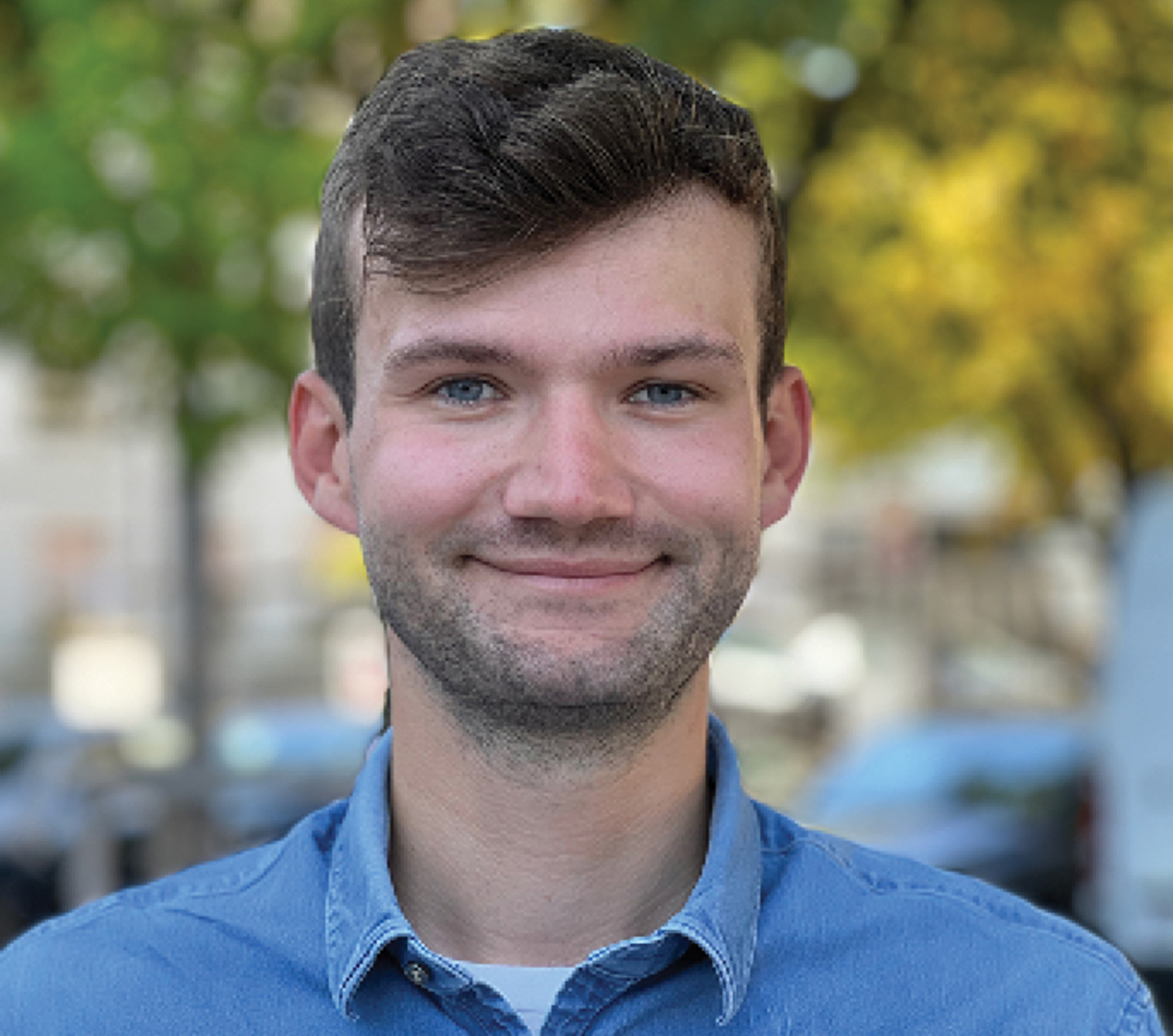
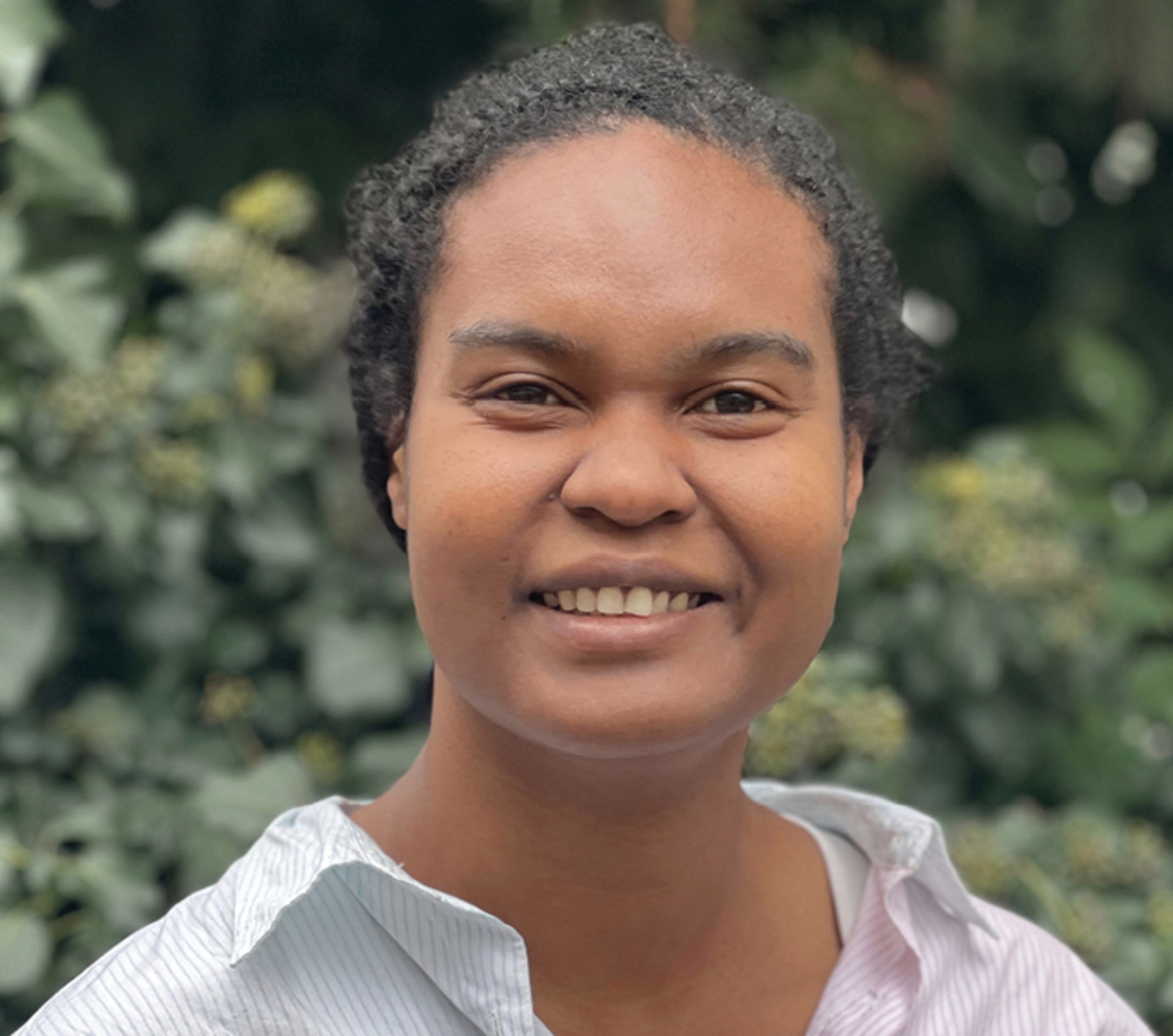
Mehdi Ramezani is now employed as an Applica- Lukas Sponfeldner is currently working as a post- Shubham Singh wrote his doctoral thesis at the tion Scientist at Chemspeed Technologies. doc at the Department of Physics at the Universi- Biozentrum of the University of Basel. He is ty of Basel. now doing research at the Karolinska Institute in Sweden. Superconducting contacts A combination of good properties Unnatural amino acids For his doctoral thesis, Dr. Mehdi Ra- For his doctoral thesis, Dr. Lukas Spon- for protein screening mezani developed a novel method for feldner manipulated and studied the op- In his doctoral thesis, Dr. Shubham equipping a two-dimensional layer of the tical and electronic properties of two-di- Singh developed and tested a screening semiconductor molybdenum disulfide mensional semiconductors. For part of toolset for incorporating unnatural with superconducting electrical contacts the thesis, he coupled different types of amino acids at specific sites in proteins. for the first time. electron-hole pairs in the van der Waals Fluorescent dyes or other biophysical For future applications in electronics, material molybdenum disulfide. probes can covalently bind to these researchers are studying semiconductors In the two-dimensional material, elec- amino acids, allowing the detailed ex- made of single atomic layers. They can trons leave their place in the “valence amination of proteins. stack such monolayers in order to de- band” due to excitation with light and Proteins are biological nanoma- velop new materials with special proper- enter the “conduction band”. This creates chines that are fundamental to the sur- ties. In part, these are based on complex a positively charged hole, which forms an vival of an organism. Understanding quantum mechanical phenomena that electron-hole pair together with the neg- how they work is therefore of great in- can be put to use in quantum technology. atively charged electron. In two-layer mo- terest for combating diseases or for pro- The method developed by Mehdi Ra- lybdenum disulfide, two different types tein engineering, for example. To study mezani is very helpful when it comes to of electron-hole pairs can form following proteins in detail, researchers transfer better studying these phenomena. excitation with light — depending on the “blueprint” of the proteins (genes) It was important to protect the sensi- whether the hole and electron are in the into mammalian cells and then let them tive atomic semiconductor layer because same layer or adjacent layers. produce the proteins. When this trans- impurities and defects strongly affect the Lukas Sponfeldner has now carried ferred genetic material is modified in a transport of electric charge. In his re- out experiments in which he coupled particular way and the genetic code is search approach, Mehdi Ramezani there- these two types of electron-hole pairs, expanded for the mammalian cells, the fore encapsulated this layer in thin layers combining the beneficial properties of ensuing protein biosynthesis results in of insulating boron nitride. Beforehand, both types. Depending on the purpose, a protein that contains unnatural amino however, he embedded the vertical su- he was therefore able to create fused par- acids at the target sites. perconducting contacts into this protec- ticles that were not only very bright but Shubham Singh has now developed tive layer. In principle, these newly de- also interacted strongly with each other. a cell-based assay to determine the in- veloped vertical contacts to the semicon- This method could also allow researchers corporation efficiency of the unnatural ductor layers could be applied to a variety to produce a novel source of single pho- amino acids via a high-throughput of different semiconductors. tons, which play an important role in screening approach. He has also devel- Publication: https://bit.ly/3WNxW3e quantum communication. In addition, oped and tested a systematic strategy Media release: http://bit.ly/3RRk3Ak the investigation and modelling of cou- for the simultaneous incorporation of Video: https://youtu.be/CsjOtEsh7qA pling are important in order to improve different unnatural amino acids into our understanding of fundamental semi- proteins produced by mammalian cells, conductor physics. thereby providing a tool for studying Publication: https://bit.ly/3HkYrre protein dynamics. Media release: http://bit.ly/3HWTd5b Video: https://youtu.be/Sq_KVBM_WzI 18 SNI Annual Report 2022
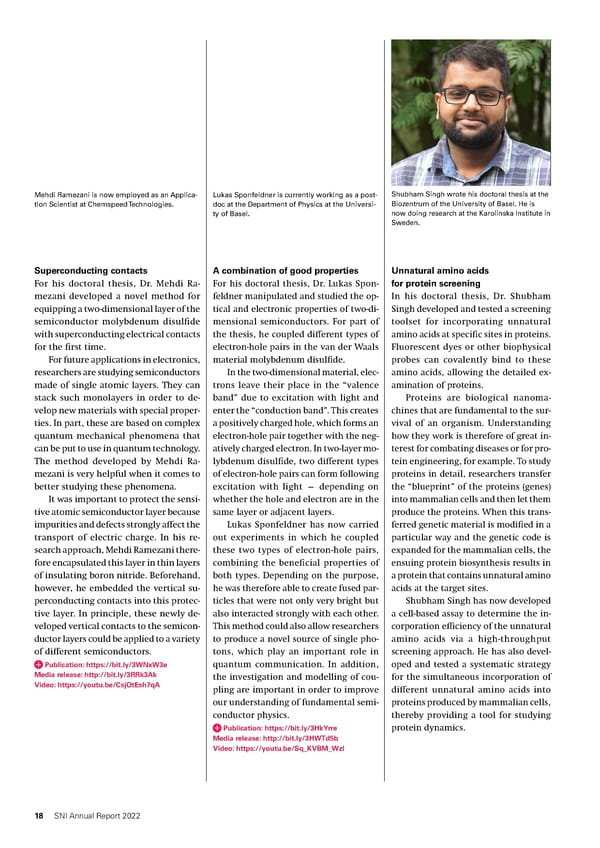
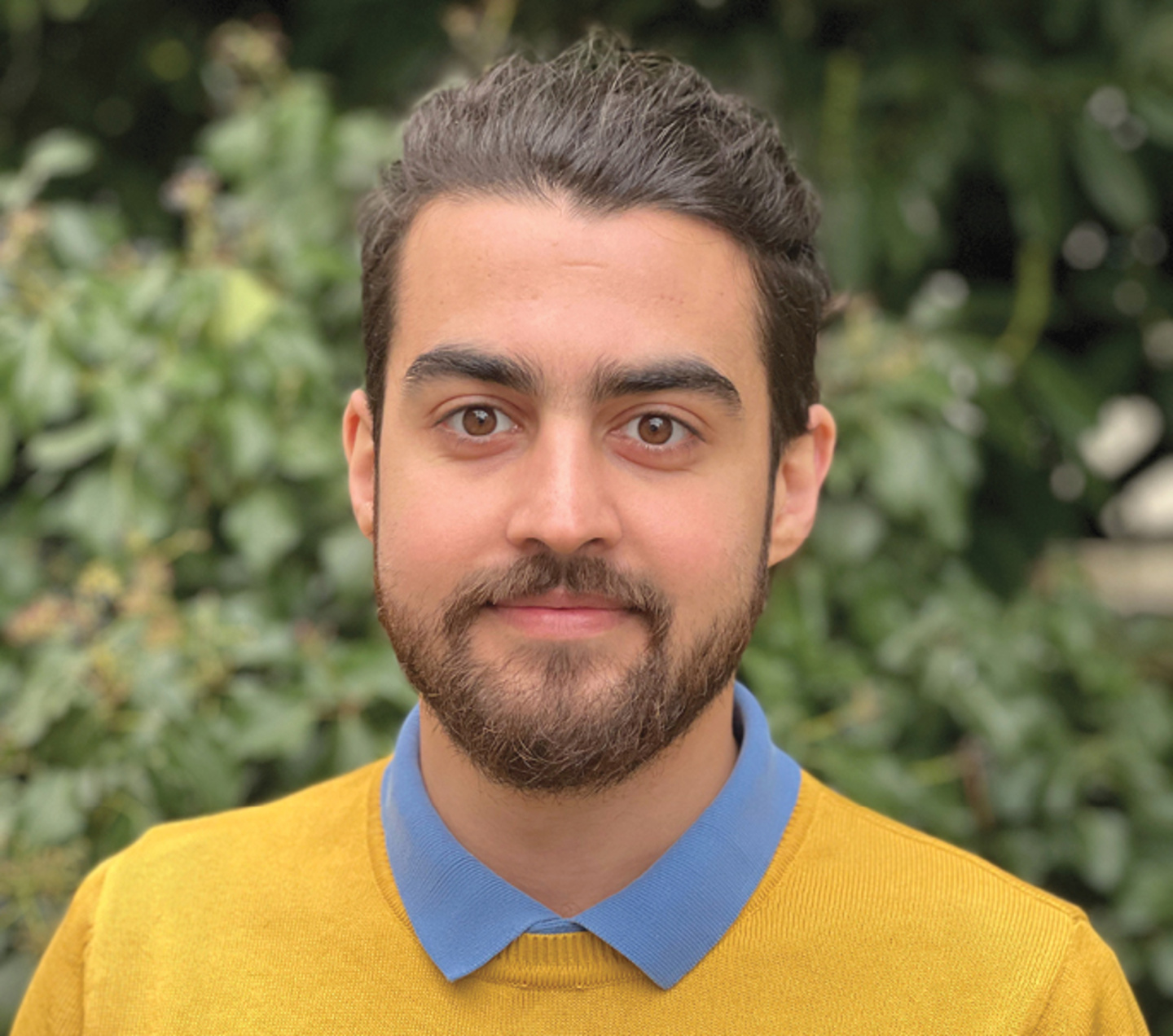
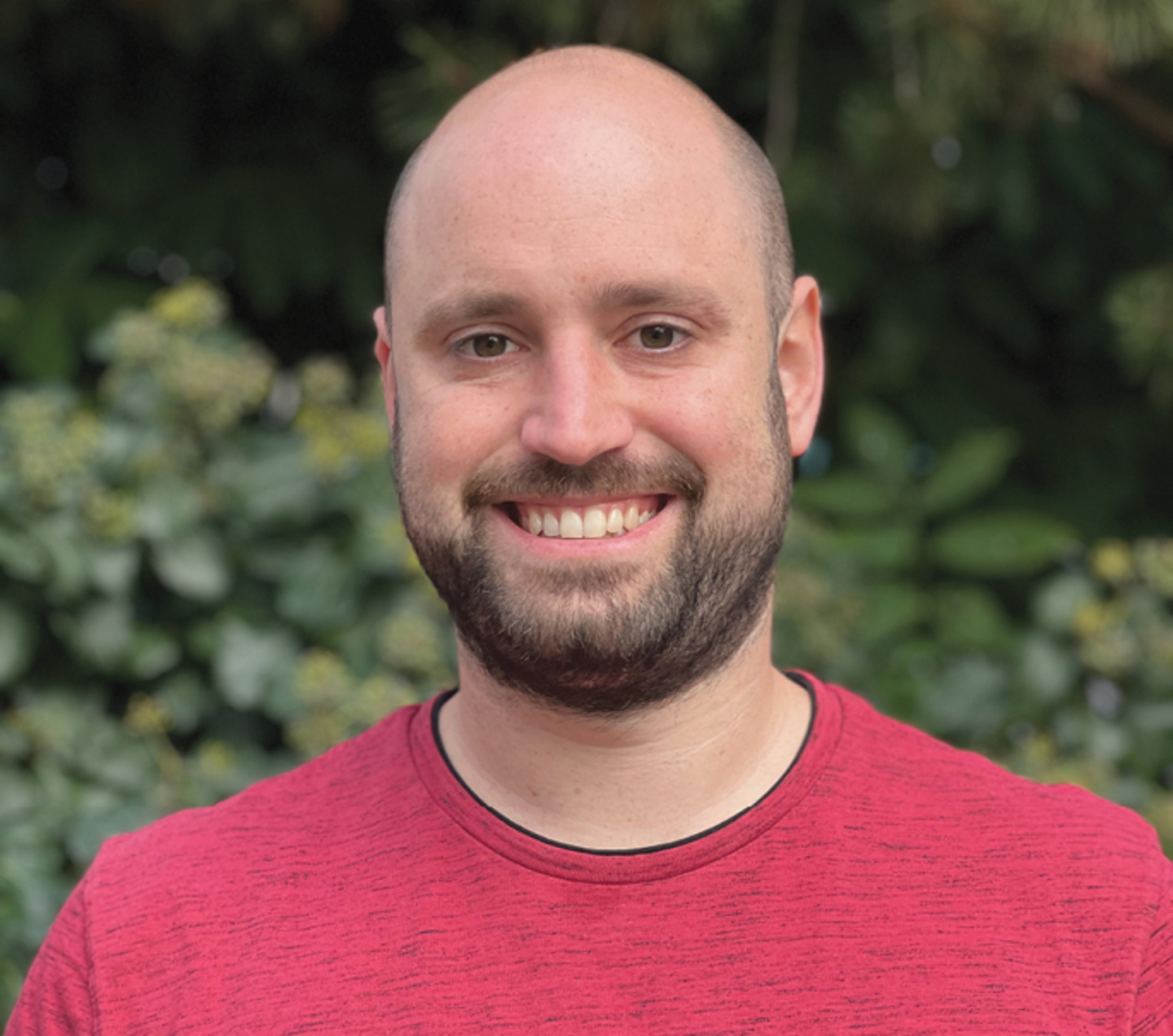
“Because everyone got along so “I would recommend the SNI PhD well, the courses as part of the SNI School to anyone who’s interested PhD School were also an opportu- in interdisciplinary science. nity to give each other open and Personally, I’d choose the SNI PhD honest feedback, which I found very School in Basel again every time.” helpful. As a result, I’m now able to Dr. Thomas Mortelmans, former SNI present my work with certainty and doctoral student and now a StepIN self-confidence.” Trainee at Johnson & Johnson Dr. Alexina Ollier, former SNI doctoral student and now a postdoc Jann Ungerer is currently a postdoc at the Department of Physics at the University of Basel. Coupling of a light quantum and a spin qubit For his PhD thesis, Dr. Jann Ungerer has coupled a single light particle (photon) with a spin qubit, the smallest informa- tion unit of a future quantum computer. With his work, he contributes to the real- ization of a spin-based quantum computer by demonstrating the possibility of using photons to couple clusters of spin qubits. Jann Ungerer has used single light par- ticles with a wavelength in the micro- wave range for this purpose. Normally, there is little interaction of photons with the intrinsic angular momentum (spin) of an electron. However, if the research- ers use a special superconducting resona- tor that stores single photons, the inter- action between photon and spin is en- hanced. In this way, Jann Ungerer has succeeded in coupling a single light par- ticle with an electron spin in a double quantum dot. Quantum dots are tiny structures in which the charge carriers are restricted in their mobility, allowing single elec- trons to be captured and manipulated. In his work, Jann Ungerer used a nanowire made of the semiconductor material in- dium arsenide, in which two different crystal structures give rise to a double quantum dot and make the coupling be- At the SNI Annual Event, the doctoral students present their tween photon and spin possible. work to the SNI network. Josh Zuber won the prize for the best Publication: https://bit.ly/3YRdAYh presentation, and Ajmal Roshan won a prize for his poster. SNI Annual Report 2022 19
Excellent Prizes for outstanding SNI doctoral students Swiss Nanotechnology PhD Award Young Researcher Award Dr. Thomas Mortelmans, a former doc- Former SNI doctoral student Dr. Alex- toral student at the SNI PhD School, was ina Ollier was presented with a Young presented with one of five PhD Awards at Researcher Award at the Interna- In 2022, former SNI doctoral stu- the Swiss NanoConvention 2022. tional Vacuum Congress 2022 in Sap- dent Thomas Mortelmans won Mortelmans received the award, poro (Japan). She received the award, one of the Swiss Nanotechnology which was sponsored by Sensirion, in rec- which is sponsored by Canon Anelva PhD Awards. ognition of a first-author publication in Corporation, for her presentation on the journal ACS Applied Nanomaterials the electronic properties of single- in which he described the development layer free graphene sheets. As part of of a novel functional principle for rapid her SNI-supported doctoral disserta- Covid-19 tests. The principle can also be tion, Alexina worked with atomically used to determine the status of the dis- thin compounds of this kind and in- ease or to detect other viruses, such as vestigated energy losses in various influenza A. two-dimensional materials. Report: http://bit.ly/3YMgmy8 Report: http://bit.ly/3lv3Tk7 Video about publication: Video: https://youtu.be/gzlXDVMMDd0 https://youtu.be/7VKskNZCoMc Video about the SNI PhD School: https://youtu.be/9dqX_vimmcY Former SNI doctoral student Alexina Ollier received a Young Researcher Award. SPS Award In 2022, the Swiss Physical Society (SPS) presented the SPS Award related to Me- trology, which was sponsored by METAS, to the former SNI doctoral student Dr. Thomas Karg. Karg and his colleagues observed strong coupling between a nanomechan- ical oscillator and an atomic spin ensem- ble for the first time. They did so by adopt- Former SNI doctoral student ing an innovative approach that used light Thomas Karg won an SPS Award. to couple the two systems over a macro- scopic distance. Published in the journal Science, these results pave the way for new applications ranging from quantum metrology and networking to quantum feedback experiments and coherent links between quantum processors. Report: http://bit.ly/3xlznvD 20 SNI Annual Report 2022
SNI Winter School Nanoscience in the Snow “I was really impressed by the quality of all the talks. It really pays dividends that we not only provide our doctoral students with scien- The SNI Winter School “Nanoscience in Snow” was held as a face-to-face event tific training but also offer them the Snow” is always a highlight for SNI again in January 2022 — this time, in Zer- courses on public speaking.” doctoral students and invited guest lec- matt. Despite the great weather and Dr. Andreas Baumgartner, coordinator turers alike. breathtaking scenery, the participants of the SNI PhD School Participants in this annual event come had no trouble concentrating on the from a wide range of disciplines and have many fascinating scientific talks or taking the opportunity to gain new insights from advantage of the opportunity for scien- leading scientists, to discuss their own tific exchange. projects in an informal setting and to Report: http://bit.ly/3lxbwXd spend a few hours together in the snow in Video: https://youtu.be/KfnFZbJneOc “Events such as the Winter School different regions of the Swiss mountains. and the SNI Annual Event are real After a forced hiatus due to the coro- highlights and taught me a great navirus pandemic, “Nanoscience in the deal about various subject areas. Today, these insights allow me to consider problems from various perspectives.” Dr. Thomas Mortelmans, former SNI doctoral student At the SNI Winter School, doctoral students from the SNI and researchers from various disciplines engage in intensive scien- tific exchange. In 2022, “Nanoscience in the Snow” was held in Zermatt. SNI Annual Report 2022 21

22 SNI Annual Report 2022
Spin correla- tion between paired electrons demonstrated There is a negative correlation between the two spins of an entangled pair of electrons from a superconduc- tor. Studies like this contribute to the understanding of quantum mechanical phenomena. More on this research on page 31. SNI Annual Report 2022 23
Research findings: The basis for various applications Basic research has always played an important role at the SNI. Only when we understand the underlying principles is it possible to devel- op sensible applications. Members of the SNI network carry out this kind of research in a wide range of areas. As part of their work, they investigate phenome- na in the often difficult to understand world of quanta, develop new methods for the analysis and imaging of tiny nanostructures, analyze novel materials or attempt to understand how natural nanomachines operate. In 2022, researchers from the SNI network published 44 publications in respected scientific journals. For the most part, these publications related to quantum mechanical or physical phenomena, as the SNI traditionally has many members with a background in physics. The following examples demonstrate, however, that the nanosciences also contribute to new insights and applications in other disciplines. 24 SNI Annual Report 2022
New rapid test could detect coronavirus Better sample preparation with the cryoWriter and flu simultaneously Researchers from the SNI network have presented an improved Researchers from the University of Basel and the Paul Scherrer microfluidic technique for preparing samples for electron mi- Institute have developed a rapid test for Covid-19 with a novel croscopy. The method allows them to avoid paper blotting, which functional principle. Although it requires further testing and im- results in a considerable loss of proteins. On the other hand, the provements, the initial results are promising: As well as deter- researchers also optimize the conditions so that there is signifi- mining whether a Covid-19 infection is present, the test also prom- cantly less damage to the sample at the air-water interface. ises to provide information on the status of the disease. It could Original publication: https://bit.ly/3HICnrQ also detect other diseases and different coronavirus variants. Media release: http://bit.ly/3YOrYRh Video: https://youtu.be/7VKskNZCoMc New approach in biosensor technology Researchers from the SNI network have developed a novel coat- ing of a polymer and carbon nanotubes that is suitable for coat- ing miniaturized electrodes. Such electrodes, in which conduc- tive nanomaterials are embedded in an antifouling matrix, can be used in point-of-care diagnostics. The novel coating protects the electrodes from contamination — which is always a problem with complex samples such as blood serum. In a paper published in ACS Applied Materials & Interfaces, the researchers used a protein associated with inflammatory responses to show that they could produce the assay within a few hours and quantita- tively detect the protein in undiluted blood serum in the nano- gram range. The Swiss Nanoscience Institute has funded this collabora- tion between researchers from CSEM, the FHNW School of Life The former SNI PhD student Thomas Mortelmans developed a rapid test for Sciences and the company MOMM Diagnostics as part of its infections with SARS-CoV-2 during his PhD thesis at the SNI PhD School. applied research program, Nano-Argovia. (Image: Paul Scherrer Institute/Mahir Dzambegovic) Original publication: https://bit.ly/3HkESPA Time-saving due to early diagnosis Researchers from the SNI network have shown that nanome- chanical sensors are ideally suited to quickly and reliably de- tect even a few bacteria in the blood. The interdisciplinary team describes in the scientific journal Biosensors how the method can be used to diagnose sepsis at an early stage — which allows more time for successful treatment. Original publication: http://bit.ly/3Rjk2VF A nanomechanical sensor can detect bacteria in a blood sample (Image: De- A novel coating for miniaturized electrodes in point-of-care diagnostics pre- partment of Physics, University of Basel) vents contamination — a problem when complex samples like blood serum are analyzed. (Image: CSEM Allschwil) SNI Annual Report 2022 25
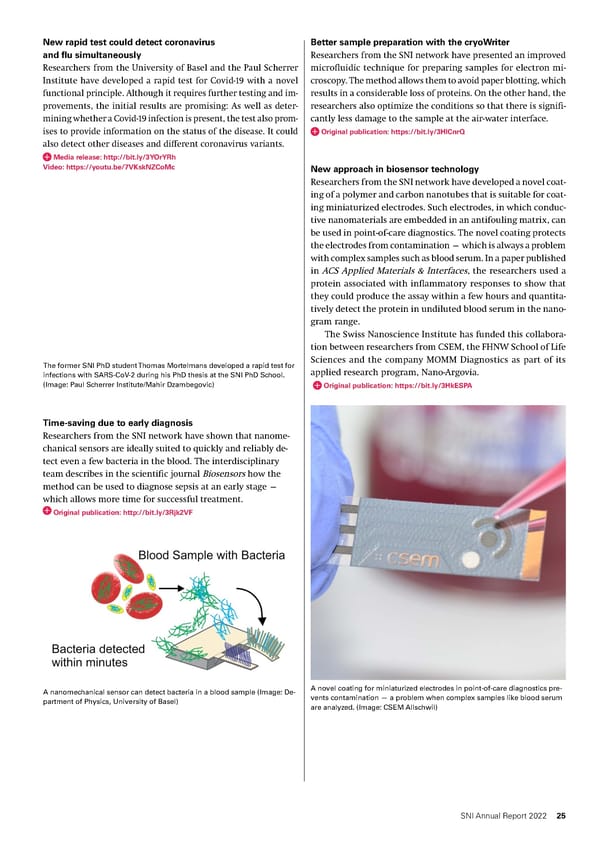
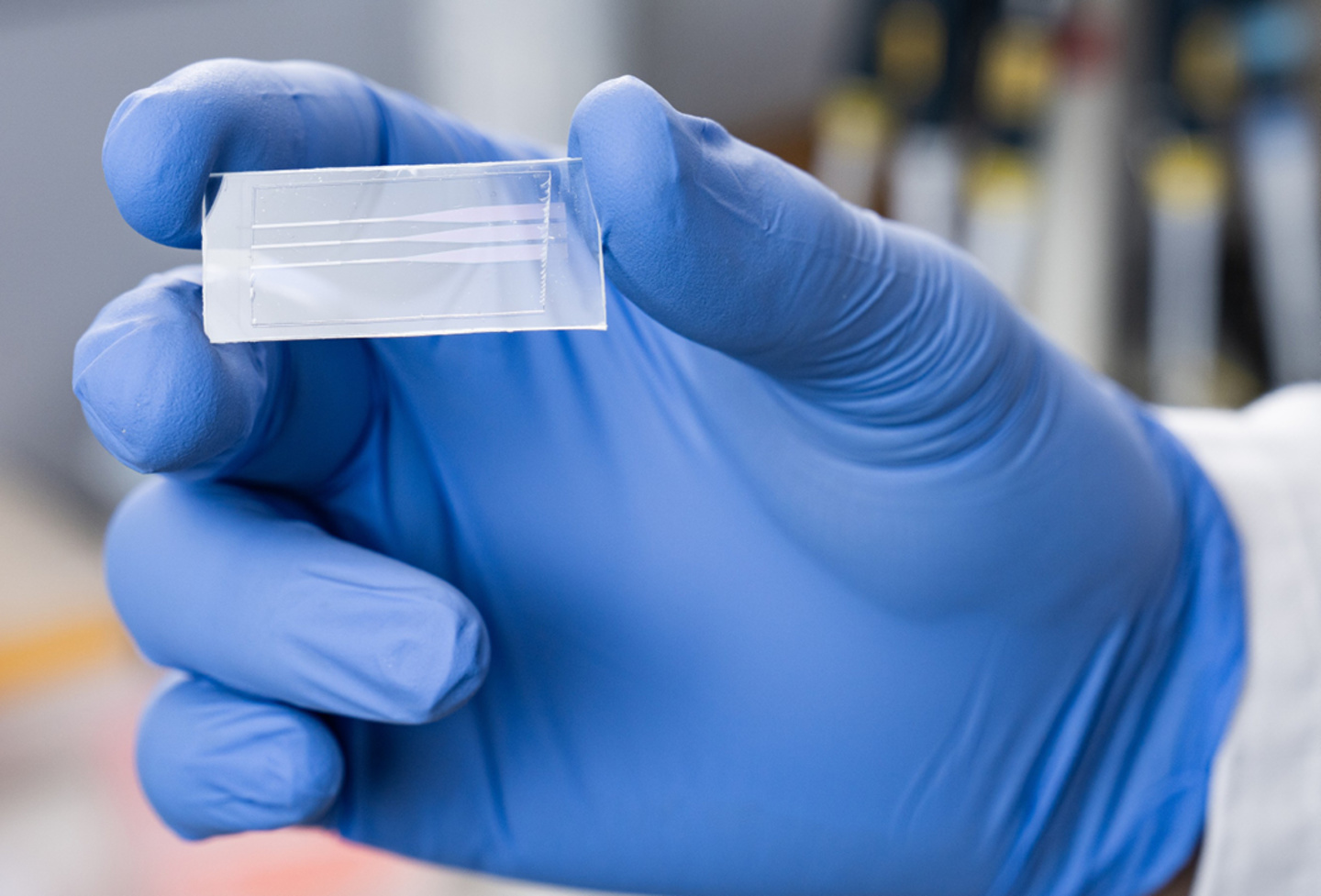
Safeguarding the cell nucleus Illustration of the nuclear pore. The nucleus is guarded by a highly secure door, the so-called (Image: Biozentrum, University of Basel) nuclear pore, that controls the transport of substances from the cytoplasm to the cell nucleus and back. A research group of Argovia professor Roderick Lim of the University of Basel has now shown that different shuttle proteins occupy the nu- clear pore to prevent unsolicited leakage of molecules. These proteins form an escape-proof, fail-safe mechanism by compen- sating for one another to fortify the pore. Media release: http://bit.ly/4142QYL 26 SNI Annual Report 2022
Nanoheating allows enzymes to operate at subzero temperatures Researchers from the SNI network have developed a strategy to allow the activity of a natural biocatalyst to continue at tem- peratures down to -10°C. To do so, a team from the SNI network from the FHNW School of Life Sciences immobilized enzymes isolated from an Antarctic yeast together with gold nanoparticles on the surface of particles of silica. When optically excited, the gold particles begin to ra- diate nanoscale heat. These tiny amounts of heat are sufficient for the neighboring enzymes, which are already adapted to cold temperatures in nature, to perform their catalytic work at tem- peratures down to -10°C. The system only works, however, if the embedded gold nanoparticles and enzymes are shielded from the environment by a nanometer-thin layer. Original publication: http://bit.ly/3D0y7kN Cycloalkanes adapt their shape when trapped in tiny pores. (Image: Depart- ment of Physics, University of Basel) Cooling matter from a distance Researchers from the University of Basel have succeeded in forming a control loop consisting of two quantum systems sep- Nano-heating enables enzymes to work at sub-zero temperatures (Image: arated by a distance of one meter. Within this loop, one quan- FHNW) tum system — a vibrating membrane — is cooled by the other — a cloud of atoms, and the two systems are coupled to one another by laser light. Interfaces such as this allow different kinds of quantum systems to interact with one another even Dancing molecules over relatively large distances and will play a key role in quan- When cycloalkanes are enclosed in nanometer-sized pores, they tum technologies of the future. adapt their shape — in a manner similar to the induced fit con- Media release: http://bit.ly/3XwRmcV cept described in biochemistry. The molecules do not all behave Video: https://youtu.be/gWER3ToDqNo the same way. With increasing lack of space and low tempera- tures below 5K, the molecules start to move in a surprising way. Researchers from the SNI network from the Department of Physics at the University of Basel and the Paul Scherrer Institute have demonstrated this using scanning tunneling microscopy images and published the results in the Journal of Physical Chemistry Letters. Original publication: https://bit.ly/3kT76cS Light is used to couple a vibrating membrane to a cloud of atoms in order to form a control loop. The two different quantum systems — consisting of the membrane and the spins — therefore regulate one another’s temperature with no need for external measurement. (Image: Department of Physics, University of Basel) SNI Annual Report 2022 27

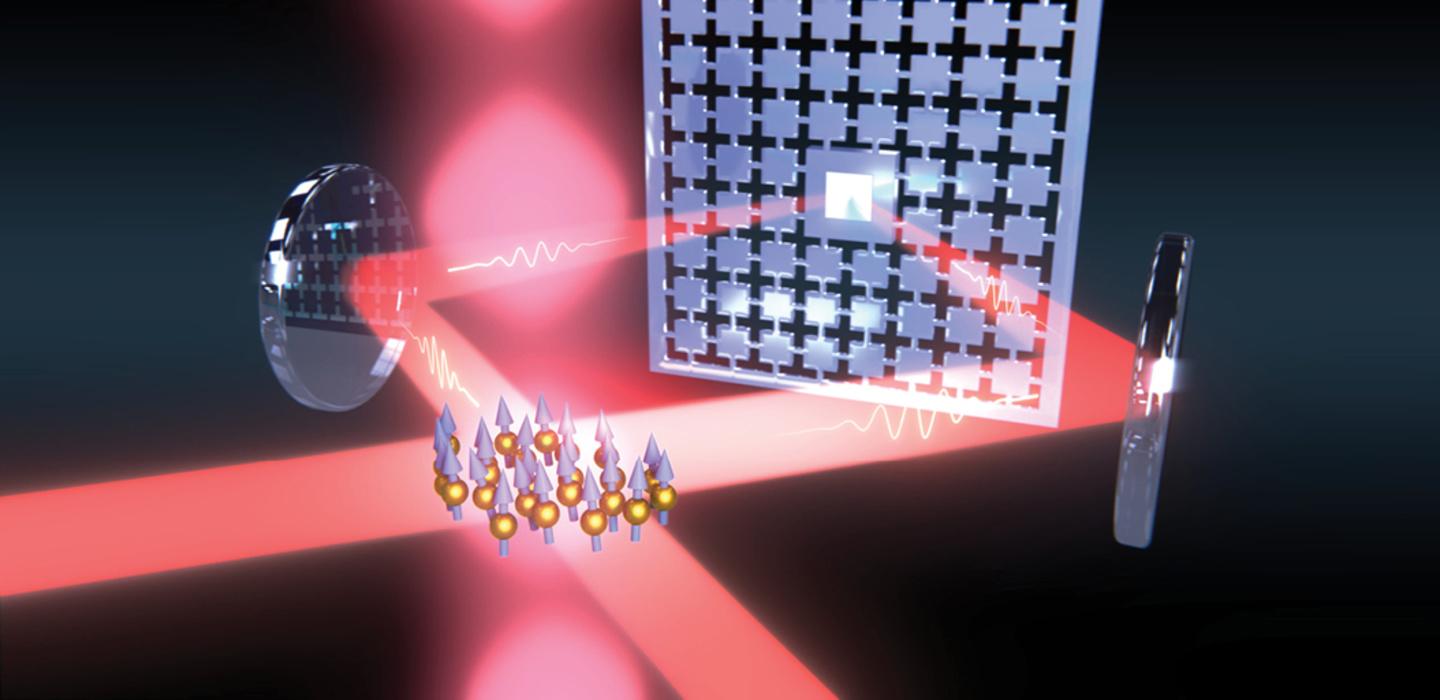
Twin photons from unequal sources Quantum interference device images Identical light particles (photons) are important for many tech- current flow in qubit circuits nologies that are based on quantum physics. A team of research- Physicists from the SNI network at the University of Basel and ers from Basel and Bochum has now produced identical photons the ETH Zurich have used a scanning superconducting quantum with different quantum dots – an important step towards ap- interference device (SQUID) to image the current flow of a su- plications such as tap-proof communications and the quantum perconducting device developed for quantum computing. The internet. data will help to optimize qubit control. The article was pub- Media release: http://bit.ly/3lyR9Jj lished in Applied Physics Letters. Video: https://youtu.be/VluqCm5PFAY Original publication: https://bit.ly/3jevmFM Although the quantum dots of the Basel researchers are different, they emit Map of the circuits magnetic field, showing the flow of current density with- exactly identical light particles. (Image: Department of Physics, University of in the device. (Image: Department of Physics, University of Basel) Basel) Laser light of any wavelength “Hot” spin quantum bits in silicon transistors Researchers from the SNI network have developed a platform Quantum bits (qubits) are the smallest units of information in for the resonant enhancement of so-called nonlinear optical pro- a quantum computer. Currently, one of the biggest challenges cesses which could help to produce laser light of any wavelength. in developing this kind of powerful computer is scalability. A They combine a wedge-shaped diamond membrane with two research group at the University of Basel, working with the IBM narrowly spaced, highly reflective mirrors (a Fabry-Perot micro- Research Laboratory in Rüschlikon, has made a breakthrough cavity). In this way, the researchers can regulate the resonant in this area. frequencies of the microcavity, and thus the wavelengths in- Media release: http://bit.ly/3HZEQgt volved in the nonlinear optical process, by tuning the distance between the mirrors and the thickness of the diamond mem- brane. In the scientific journal Optica, the team of scientists from Stanford, Calgary and Basel report that their approach could pave the way for a universal frequency shifter for laser light. Media release: http://bit.ly/3Ih2ipR The newly developed qubits are based on so-called holes (red) whose spin (arrow) in one or the other direction stores the information. They are arranged in an architecture based on silicon transistors. (Illustration: NCCR Spin) The platform with two closely spaced, highly reflective mirrors and a wedge-shaped diamond membrane paves the way for a universal, low-threshold frequency shifter for laser light. (Image: Flågan, Riedel and Scixel) 28 SNI Annual Report 2022
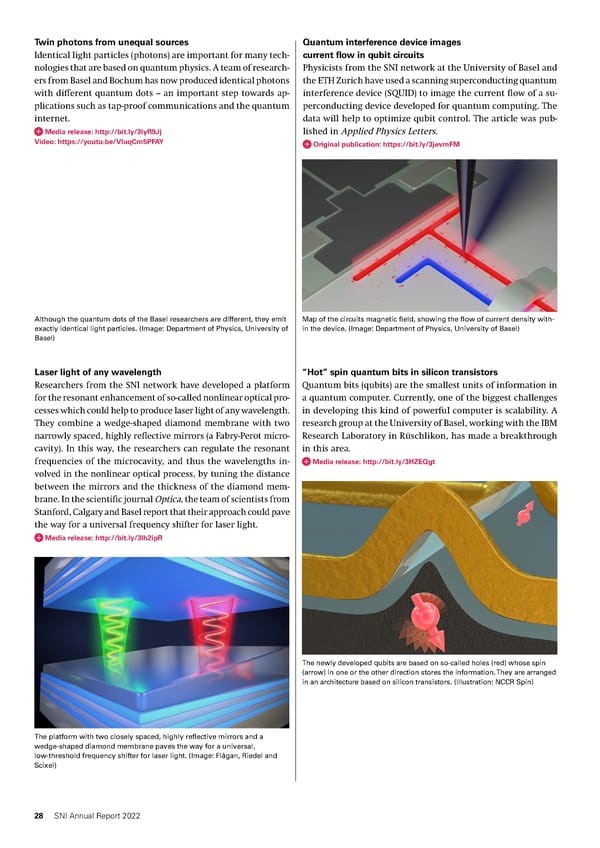
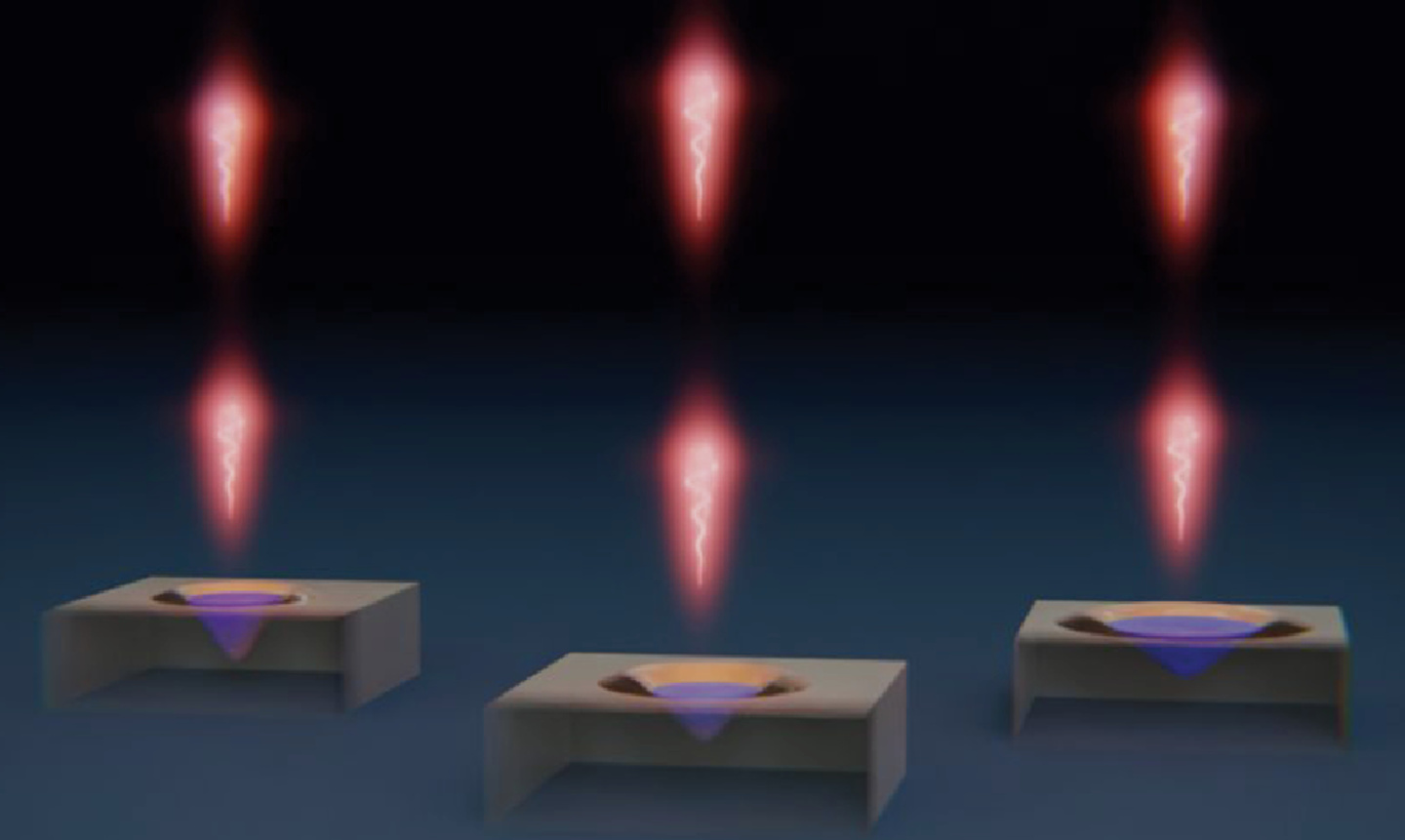
Unexpected speed-dependent friction Surprisingly, the friction between the tip of an In the macro world, friction doesn’t depend on the speed at atomic force microscope and the Moiré super- which two surfaces move past one another, but researchers structures depends on the speed at which the tip is moved across the surface. (Image: Department from Basel and Tel Aviv have now observed precisely this effect of Physics, University of Basel and Scixel) in special graphene structures on a platinum surface. Media release: http://bit.ly/3Yz7495 SNI Annual Report 2022 29
Methods for the investigation of two-dimensional Coupling of electron-hole pairs materials For the first time, physicists from the University of Basel have In a review article in the scientific journal Nature Reviews Phys- succeeded in coupling different types of electron-hole pairs (ex- ics, researchers led by Argovia professor Martino Poggio pub- citons) in the van der Waals material molybdenum disulfide. lished an analysis of imaging methods for weak magnetic fields. This successful coupling allows them to utilize and control the The publication provides a technical overview of various meth- different properties of the two types of electron-hole pairs — ods suitable for studying 2D materials, offering opportunities and could pave the way for the production of a novel source of to investigate phenomena such as superconductivity. individual particles of light (photons). Moreover, the study and Original publication: https://bit.ly/3HMy2DX modeling of exciton-exciton coupling is key to gaining a better understanding of the underlying semiconductor physics. In col- laboration with colleagues from the University of Toulouse, the researchers published their findings in the journal Physical Re- view Letters. Media release: https://bit.ly/3HWTd5b Video: https://youtu.be/Sq_KVBM_WzI New probe for imaging magnetic fields Argovia professor Martino Poggio’s team has developed a new scanning probe for nanometer-scale superconducting quantum interference device (SQUID) microscopy based on a non-contact atomic force microscopy cantilever. The probe enables imaging of magnetic fields with nanometer spatial resolution. The pub- lication in the scientific journal Physical Review Applied is a contribution to a FET Open project led by the Poggio team. Original publication: https://bit.ly/3YwAZyj Researchers from the SNI network have compared different imaging meth- ods for weak magnetic fields that enable nanometer-scale resolution. (Imag- es: Department of Physics, University of Basel) The new probe enables high-resolution imaging of weak magnetic fields. (Image: Department of Physics, University of Basel) 30 SNI Annual Report 2022
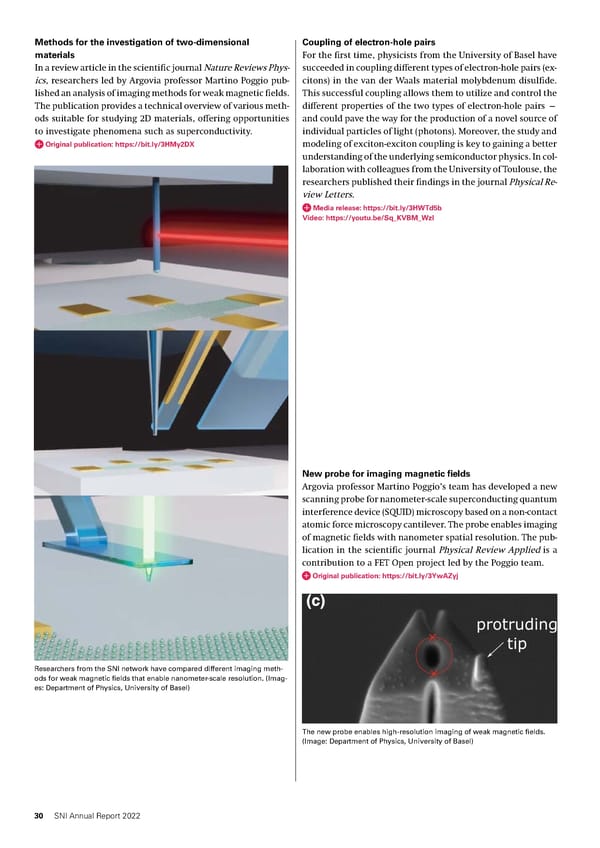
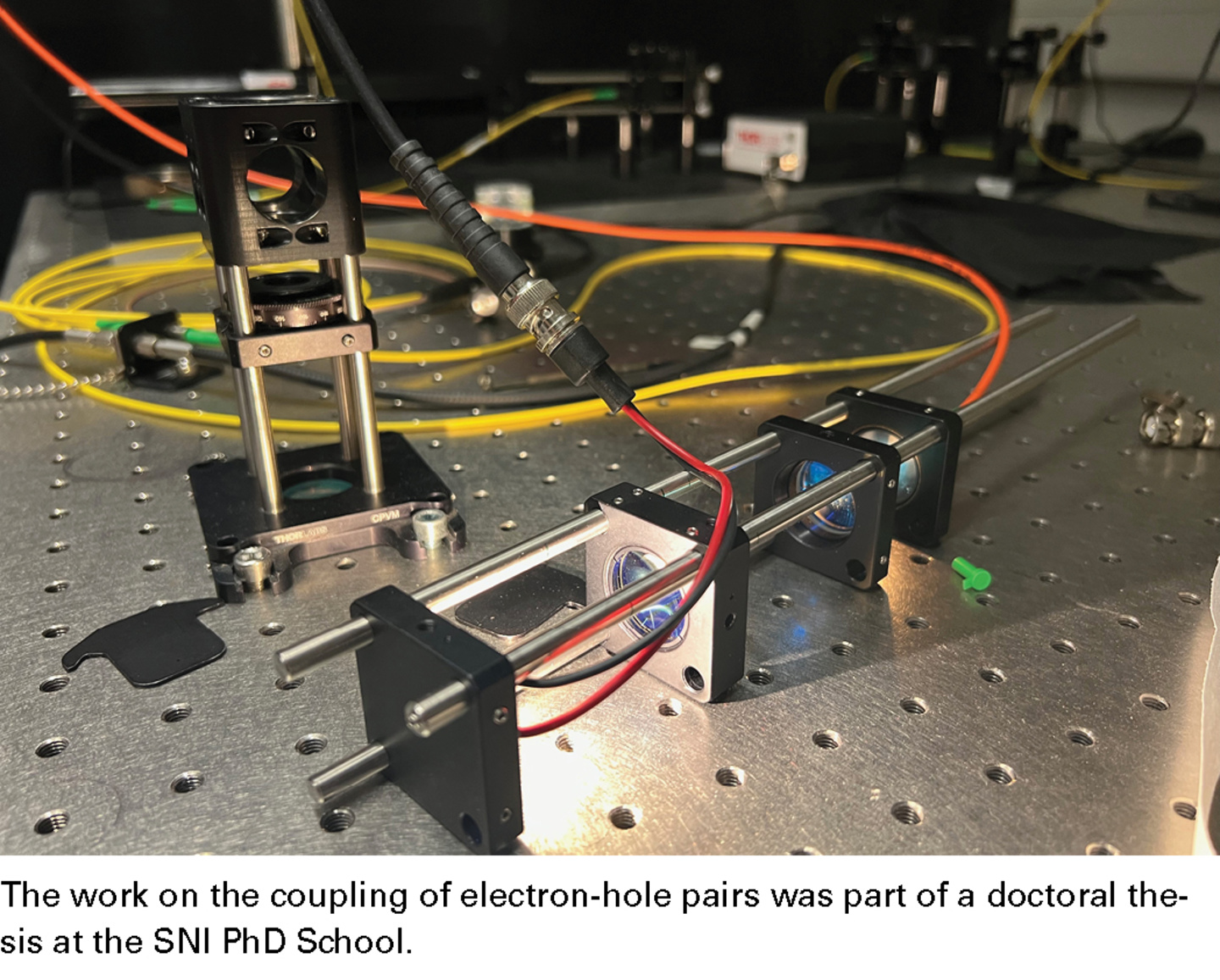
Spin correlation between paired electrons demonstrated Ultracold circuits Physicists at the University of Basel have experimentally demon- Cooling materials to extremely low temperatures is important strated for the first time that there is a negative correlation for basic physics research as well as for technological applica- between the two spins of an entangled pair of electrons from tions. By improving a special refrigerator and a low-temperature a superconductor. For their study, the researchers used spin thermometer, Basel scientists have now managed to cool an filters made of nanomagnets and quantum dots, as they report electric circuit on a chip down to 220 microkelvin – close to in the scientific journal Nature. absolute zero. Media release: http://bit.ly/3HXn8dn Media release: http://bit.ly/3luYc5x The cryostat used by the Basel physicists to reach a record temperature of 220 microkelvin. The special thermometer along with a scale bar can be seen in the centre of the image (golden rectangle). (Image: Department of Electrons leave a superconductor only as pairs with opposite spins. If both Physics, University of Basel) electron paths are blocked for the same type of spin by parallel spin filters, paired electrons from the superconductor are blocked and the currents de- crease. (Image: Department of Physics, University of Basel and Scixel) Electrospray method expands range of different graphene ribbons Floating thanks to sound waves Researchers from the SNI network have accessed various Researchers from the SNI network are investigating methods graphene nanoribbons using high-vacuum electrospray depo- to keep particles in the air using sound waves (acoustic levita- sition. They succeeded in investigating longer graphene na- tion) — for example, for crystallographic studies of proteins. In noribbons with properties that are difficult or impossible to a paper in Applied Physics Letters, they investigate ultrasonic achieve with surface synthesis. For example, various tempera- rotors as sample holders. They show the influence of the size ture-sensitive functional groups can be integrated in solution, and shape of the rotors, which help to achieve controlled rota- or twisted graphene ribbons can be produced. The high-vacuum tion of the samples held acoustically in suspension. The shape electrospray method also allows the deposition of graphene and size of a rotor affect how the rotor is levitated and rotates nanoribbons on substrates that were previously unavailable for with the help of ultrasonic waves. on-surface synthesis. Original publication: https://bit.ly/3HiP2QW Original publication: https://bit.ly/3jewI3k With high-vacuum electrospray deposition, extended graphene nanorib- bons with special properties can be accessed for high-resolution studies. (Image: S. Scherb, Department of Physics, University of Basel) Tiny rotors can be kept in suspension by acoustic waves. (Image: S. Jia, Biozentrum, University of Basel) SNI Annual Report 2022 31
32 SNI Annual Report 2022
New electrodes for complex samples Researchers working on the Nano-Argovia project PEPS have developed a new type of coating for miniature electrodes in point-of-care laboratory diagnostics. The coating contains conductive nanomaterials and prevents contamination. Working within the framework of the SNI’s Nano-Argovia program, interdisciplinary teams of researchers investigate applied research topics in collaboration with at least one partner from industry. One of the participants in the Nano-Argovia project PEPS was MOMM Diagnostic — a startup founded by a former nanoscience student. More information on page 40 SNI Annual Report 2022 33
Nano-Argovia program: Applied interdisciplinary projects in collaboration with companies from Northwestern Switzerland Since the SNI was founded, it has promoted technology and knowledge transfer as part of the Nano-Argovia program. In 2022, the SNI supported a total of 12 applied research projects in collaboration with industrial compa- nies from Northwestern Switzerland. A wide range of topics were addressed, with some projects investigating medical or diagnostic applications and others focusing on improved meth- ods for analyzing or processing various materials. Half of the partner companies in 2022 came from the Canton of Aargau, and the other half came from one of the two Basel half cantons. Partners included not only young startups but also established companies from the region. In 2022, the ANAXAM technology transfer center, of which the SNI is a founding member, also took part in one project as part of the Nano- Argovia program. 34 SNI Annual Report 2022
The nanobodies are produced in a bioreactor at Innovative combination to combat cancer the FHNW School of Life Sciences and then com- In the Nano-Argovia project B7H3 Nanobody PC, researchers are bined with a polymer. (Image: O. Germershaus, FHNW) developing a novel nanobody-polymer conjugate to image and treat malignant tumors. It is a combination of a cell-specific nanobody, which acts very similarly to antibodies but is much smaller and which binds specifically to certain cancer cells, and a polymer that can be loaded with different compounds. The nanobody-polymer conjugate will be designed to cross the blood-brain barrier and then bind to the specific target molecule on the surface of cells of malignant brain tumors. Depending on the active substance that is bound to the nanobody-polymer conjugate, cancer cells in the brain may be combated or imaged. Cooperation with: CIS Pharma AG // FHNW School of Life Science // Paul Scherrer Institute // University Children’s Hospital Zurich (without funding from the SNI) Project description: http://bit.ly/3lrxFGd “We are optimistic that our modularly applicable technology with its high degree of flexibility is also suitable for diagnosing and treating cancers that require a crossing of the blood-brain barrier.” Dr. Christian Geraths, CSO at CIS Pharma AG SNI Annual Report 2022 35
Foldable and rollable Functional test before shock freezing In the Nano-Argovia project META-DISPLAYS, researchers were In the Nano-Argovia project FuncEM, researchers have been developing a component for foldable and rollable screens that developing an extension to the cryoWrite system. This system specifically alters and controls the propagation of light. This can be used to flash-freeze tiny quantities of samples — with so-called metasurface phase retarder has tiny structures on its no loss of material — before they are examined using cryo-elec- surface that can effectively control the phases of the electro- tron microscopy. The extension module enables imaging of the magnetic field emitted by the light source. The phase retarder “living” samples using fluorescence and dark-field light micros- must also be color-neutral, allow light to pass through it easily copy immediately before the freezing process. The interdisci- and reduce back reflection. The team has now identified a com- plinary team initially focused on the investigation of thin cilia, bination that achieves high transmission and color neutrality, which also play a crucial role in numerous diseases. The up- and reduces the thickness of the phase retarder, making it suit- stream light microscopic examination provides relevant infor- able for foldable and rollable screens. mation about the functionality of the cilia examined. Cooperation with: Rolic Technologies Ltd // CSEM // Paul Cooperation with: cryoWrite AG // Biozentrum, University Scherrer Institute of Basel // Paul Scherrer Institute Project description: http://bit.ly/3Xw9YtE Project description: http://bit.ly/3K62L0A Influence of cosmic radiation In the Nano-Argovia project CRONOS, an interdisciplinary team of scientists has been investigating the effect of cosmic radiation on power semiconductors designed for high electrical currents and voltages. The team irradiated the power semiconductors with protons in a controlled manner while simultaneously ap- plying an electrical voltage. Electrical and thermal stress tests of the gate oxide layers provided information on how physical processes can lead to failures and support the development of more robust power semiconductors. Cooperation with: SwissSEM GmbH // FHNW School of Engineering // ANAXAM Project description: http://bit.ly/3xfcxpv In the Nano-Argovia project FuncEM, researchers are developing a supple- mentary module for the cryoWrite system. (Image: Biozentrum, University of Basel) “For us, the Nano-Argovia project CRONOS is an ideal opportunity to collaborate with experts in the field of power semiconductors and materials analysis and to benefit from their know-how.” Dr. Arnost Kopta, CTO SwissSEM Technologies AG In the Nano-Argovia project CRONOS, researchers are investigating the ef- “A metasurface device will allow Rolic to strengthen fect of cosmic radiation on power semiconductors. (Image: FHNW) its competitive advantage as a material supplier to the display industry.” Dr. Richard Frantz, head of development, Rolic Technologies Ltd 36 SNI Annual Report 2022
Lens combination for biomedicine Tiny magnetic field sensor with great potential In the Nano-Argovia project ACHROMATIX, an interdisciplinary In the Nano-Argovia project Nanocompass, researchers have team has developed a novel lens system that can be used for developed a novel, nanoscale magnetic field sensor that can be transmission X-ray microscopy. The lens combination is in- manufactured industrially and is expected to find applications tended to compensate for the so-called chromatic aberration of in numerous fields such as quality control or medical technol- different lenses and should be suitable for biomedical analyses. ogy. The magnetic field sensor is tiny, measuring less than 100 The researchers first calculated theoretically which lens com- x 100 nanometers. Therefore, many of these sensors can be bination was best suited for the X-rays used. Using state-of-the- combined on a single chip along with their conditioning and art nanofabrication techniques, they manufactured, character- processing electronics. In addition, the power consumption is ized and tested the different X-ray lenses in order to identify low for a tiny sensor like this. In their approach, the researchers the optimal combination. combined the so-called fluxgate principle, which has so far been Cooperation with: XRnanotech GmbH // Paul Scherrer In- used mainly for macroscopic sensors, with a spintronic device stitute // Biomedical Science Center, University of Basel based on the rules of quantum mechanics. Project description: http://bit.ly/3HY8XVs Cooperation with: Camille Bauer Metrawatt AG // FHNW School of Life Sciences // FHNW School of Engineering Project description: http://bit.ly/3Yq17ed Colorized scanning electron micrograph of a high-density array of 100 nm magnetic tunnel junctions used as nanoscale magnetic sensors. (Image: FHNW) “The Nanocompass project has opened up new perspectives for us in energy measurement technol- ogy, especially in the contactless determination of electrical currents.” Max Ulrich, Managing Director at Camille Bauer Metrawatt AG The lens combination developed in the Nano-Argovia project ACHROMATIX optimizes transmission X-ray microscopy. (Image: J. Vila Comamala, Paul Scherrer Institute) SNI Annual Report 2022 37
Template against inflammation In the Nano-Argovia project LIGARECO, the inter- In the Nano-Argovia project LIGARECO, researchers have devel- disciplinary team has cultivated ligament-forming cells in hydrogels patterned with channels. The oped a microstructured, resorbable hydrogel template that pre- aim is to increase soft tissue strength and there- vents inflammation of dental implants. Similar to a natural by prevent inflammation of dental implants. tooth, the template stimulates the formation of collagen fibers (Image: FHNW, UZB, NovoNexile) around the implant neck and thus supports the anchoring of the implant in the surrounding soft tissue. This creates a barrier to prevent bacterial invasion and thus protects the implant from bacterial infection. The researchers first focused on the fabrication of the hy- drogel template and then investigated various micro and nano- structures of the hydrogels to control the settlement of liga- ment-forming cells and the formation of the desired fibers. Cooperation with: NovoNexile AG // FHNW School of Life Sciences // University Center for Dentistry at the Universi- ty of Basel Project description: http://bit.ly/3jTYzWV 38 SNI Annual Report 2022
Adapted detector for cryo-electron microscopy Patch against ulcers in the mouth Cryo-electron microscopy has made tremendous progress in re- In the Nano-Argovia project Hydrogel Patch, researchers have cent years and nowadays allows three-dimensional imaging of developed a patch to be used for non-specific ulcers in the oral proteins in their natural environment in the cell. In the Nano-Ar- mucosa. The patch covers the affected areas and can deliver govia project HPDET-EM, an interdisciplinary team has collabo- healing agents. The patch, which is made of a self-assembling rated to install, test and apply a new detector in an electron synthetic peptide hydrogel, adheres well to the soft, moist oral microscope that is better adapted to the needs of cryo-electron mucosa and is free of animal ingredients. The researchers tested microscopy (cryo-EM) than detectors used for synchrotron and various methods and substances to cross-link and stabilize the X-ray analysis. The hybrid pixel detector tested has a high read- hydrogel and investigated biocompatibility and integration of out speed and sensitivity and is, therefore, particularly suited nanocapsules that release active ingredients. to further advance cryo-EM technology in the life sciences. Cooperation with: vVardis AG // FHNW School of Life Sci- Cooperation with: DECTRIS AG // Biozentrum, University ences // University Center for Dentistry at the University of Basel // Paul Scherrer Institute of Basel Project description: http://bit.ly/3K7PGDM Project description: http://bit.ly/3RYWBB5 In the Nano-Argovia project HPDET-EM, researchers are applying a new de- Electron micrograph of the peptide used in the Nano-Argovia project Hydro- tector adapted to the needs of cryo-electron microscopy. The image shows gel Patch. (Image: L. Kind, FHNW) E. coli bacteria as well as a bacteriophage (marked with the arrow) and gold particles. (Image: M. Er-Rafik, Biozentrum, University of Basel) “The Nano-Argovia project supports our efforts to “We are confident that this collaboration will help develop innovative and intelligent regeneration us to play a critical role in the important new market systems for oral applications.“ segment of cryo-electron microscopy.” Michael Hug, Co-CSO at vVardis AG Dr. Sacha de Carlo, Global Sales Manager EM at Dectris AG SNI Annual Report 2022 39
Short laser pulses to process nanomaterials Rapid test for pregnancy poisoning In the Nano-Argovia project NanoLase, researchers have devel- The researchers in the Nano-Argovia project PEPS are aiming oped a low-cost, reliable and compact laser source that generates to provide rapid and precise information on pregnancy poison- ultrashort pulses. The researchers applied a laser amplifier made ing, a complication during pregnancy. To this end, they have of titanium-doped sapphire with a new single-crystal fiber (SCF) produced an electrochemical sensor for certain protein bio- geometry. The extremely short laser pulses reduce heat genera- markers using conductive nanocomposite electrodes made of tion to a very small area, enabling processing on the micrometer a mixture of carbon nanotubes and a hydrophilic polymer that and nanometer scales. can be produced at low cost. Thanks to this combination, the In addition to industrial materials processing, such a laser electrodes possess high conductivity as well as repellent prop- source is of great use in the life sciences and numerous other erties that effectively protect against contamination of the sen- scientific applications. sor surface. The plan is to integrate the sensor into a novel di- Cooperation with: TLD Photonics AG // FHNW School of agnostic device that is suitable for so-called near-patient labo- Engineering // Paul Scherrer Institute ratory diagnostics without the need for complex diagnostic Project description: http://bit.ly/3lzbtKe equipment. Cooperation with: MOMM Diagnostics GmbH // CSEM Allschwil // FHNW School of Life Sciences Project description: http://bit.ly/3Yve6vm Experimental setup of the femtosecond laser. Blue light is emitted by the new pump diodes. (Image: B. Resan, Institute for Product and Production Engineering at FHNW Windisch) “The NanoLase project is very promising for TLD A new type of coating on miniaturized electrodes for near-patient laboratory Photonics as it can bring about a new product line diagnostics prevents contamination – a problem with complex samples such for TLD Photonics, making a breakthrough from as blood serum. (Image: CSEM Allschwil) laser micro to laser nanomachining.” Stephan von Wolff, CEO of TLD Photonics AG “The Nano-Argovia Project PEPS has enabled us to investigate whether our nanocomposite electrodes are suitable for use in highly sensitive electrochemical POC assays.” Dr. Mathias Wipf, Founder and CEO of MOMM Diagnostics with a master in nanosciences from the University of Basel 40 SNI Annual Report 2022
In the Nano-Argovia project NANO-thru-BBB, a new platform has been de- Therapy directly in the brain veloped for designing nanoparticles with the potential to cross the blood– In the Nano-Argovia project NANO-thru-BBB, researchers have brain barrier. The image shows immunofluorescence detection of nuclei (blue), lysosomes (LAMP1, red) and NPs (green) in human brain endothelial developed a platform for the production of nanoparticles that cells (hCMEC/D3). (Image: N. Santacroce and C. Wu, FHNW) are able to effectively overcome the selective barrier between the brain and the bloodstream. The nanoparticles will later be applied to package and deliver enzymes to the brain for the treatment of hereditary lysosomal storage diseases. The inter- “The possibility to deliver therapeutic enzymes to disciplinary research team first investigated experimentally the the brain would be a major breakthrough for effect of chemically modified and structured surfaces of the patients of lysomal storage diseases. The Nano- nanoparticles using various in vitro and in vivo models, and Argovia projects support Perseo pharma’s motiva- then used computer analyses to calculate the ideal surface struc- tion to provide preclinical proof of concept for this ture for passing the blood-brain barrier. In the long term, the approach and to further develop a new generation project will provide a solid database to conduct clinical trials of enzyme replacement therapies.” with optimized nano-formulated enzymes against metabolic Dr. Ing. Yves Dudal, CEO of Perseo pharma AG diseases. Cooperation with: Perseo pharma AG // FHNW School of Life Sciences // Department of Pharmaceutical Sciences, University of Basel Project description: http://bit.ly/3Ik1Ack SNI Annual Report 2022 41
Precious insights The team at the Nano Imaging Lab uses various microscopes to examine tiny structures thereby supporting a wide variety of research projects. Together with the newly founded Nano Fabrication Lab, the Nano Imaging Lab forms the Nano Technology Center of the SNI. These two service units offer customers from industry and academia a comprehensive service in the field of imaging and processing of surfaces as well as in micro and nanofabrication. More from page 44 onward 42 SNI Annual Report 2022
SNI Annual Report 2022 43
Nano Technology Center: Professional services and research Alongside education and research, the imaging services provided by the Nano Imaging Lab have become a key element of the SNI’s work in recent years. In 2022, the SNI also founded the Nano Fabrication Lab as a new service unit in order to provide professional assistance to research groups and to bring together the various activities relat- ing to micro and nano fabrication at the University of Basel. Together, the Nano Imaging Lab and the Nano Fabrication Lab make up the SNI Nano Technology Center, which is led by Professor of Physics, Dr. Ilaria Zardo. The Nano Imaging Lab further optimized its outstanding range of equipment in 2022. Thanks to these investments, the six-person team is now even better equipped to provide customers from univer- sities and industry with optimum processing, analysis and imaging techniques. In 2022, the team processed a total of over 175 orders from over 120 different customers and in some cases made key sci- entific contributions to research projects. Fascinating images from the micro and nano world not only allow scientists to obtain new findings, but also provide non-experts with insights into the world of tiny structures as part of outreach activities. The SNI’s Nano Fabrication Lab (NF Lab) began operating in August 2022 with two members of staff bringing together the necessary technical equipment from various working groups of the Department of Physics at the University of Basel and put organizational measures in place to improve the efficiency and safety of clean room operation. Now, they’re setting their sights on expanding the infrastructure. In 2022, the NF Lab’s services were used by 11 research groups with a total of 77 users from the University of Basel and made significant contributions to several publications in renowned scientific journals. Nano Technology Center: https://nanoscience.unibas.ch/en/services/ 44 SNI Annual Report 2022
The Nano Fabrication Lab also includes the clean Founding of the Nano Fabrication Lab room at the Department of Physics. Here, Arnold Professional nanofabrication at the SNI Lücke (left) and Gerard Gadea (right) help re- searchers fabricate micro and nano structures. Today, the accurate and efficient fabrication of micro and nano structures is a fundamental prerequisite for many questions in the field of nanotechnology. In summer 2022, various existing activities and infrastructure from different laboratories at the Department of Physics were therefore brought together at the Swiss Nanoscience Institute, and the Nano Fabrication Lab (NF Lab) was founded. Physicist Dr. Gerard Gadea became head of the NF Lab on 1 August 2022 and is supported in his work by technical assistant Arnold Lücke. The two scientists have many years of experience in nanofabrication and are working together to build up this new service unit, which will make the University of Basel fit for the future when it comes to nanofabrication. The team of the NF Lab first improved efficiency and safety in the clean room by implementing organizational changes and are now working to expand the infrastructure with equipment including two new lithography systems (electron- and laser-based), a metal “Founding the Nano Fabrication evaporator and chemical exhaust hoods. Lab has allowed us to provide ef- The Nano Fabrication Lab also includes the clean room at fective services in the fields of the Department of Physics and plans to rent a second clean micro and nano fabrication.” room in the new building of the Department of Biosystems Professor Ilaria Zardo, who is Science and Engineering of ETH Zurich in Basel, providing a responsible for the SNI Nano further significant improvement in working conditions. Found- Technology Center on the ing the NF Lab will not only make micro and nano fabrication SNI Executive Committee more effective in the future but will also facilitate the imple- mentation of safety concepts, reduce costs through centralized organization, and improve the quality of nanofabrication pro- cesses thanks to professional scientific assistance. SNI Annual Report 2022 45
The NI Lab team has analyzed dye-sensitized solar cells and Geared toward the future imaged the cross section of an electrode (TiO with gold 2 The Nano Imaging Lab is focused nanoparticles) in transmission mode (left) and scanning trans- mission mode (right). (Image: Nano Imaging Lab, SNI, Univer- on materials science sity of Basel) In 2022, the Nano Imaging Lab (NI Lab) team presented its new transmission electron microscope (JEM-F200) to the public and successfully used it to address a variety of questions. In scanning mode, the new instrument can be used to image samples at atomic resolution. For example, with a resolution limit of less than 0.2 nanometers, the instrument is able to visualize the crystal structure or interfaces of different materials — and its integrated EDX system also allows it to analyze the chemical composition at different points in the sample. With their work on the JEM-F200, the staff of the Nano Im- aging Lab have provided considerable assistance to researchers from various departments of the University of Basel and have been able to clarify key aspects relating to the analysis of vari- ous materials, as demonstrated by the four examples below. In one instance, the NI Lab team analyzed electrodes from new types of solar cells for the group led by Professor Markus Kalberer (Department of Environmental Sciences), obtaining meaningful results using the high-resolution microscope in its 46 SNI Annual Report 2022
transmission and scanning transmission modes. In collabora- In 2022, the NI Lab not only began operating the new JEM-F200 tion with Professor Jonathan de Roo (Department of Chemistry), but also acquired another high-power microscope. The new the NI Lab team analyzed the morphology of nanocrystals pro- instrument is a “dual beam electron microscope” (Versa 3D duced in de Roo’s group. Nanocrystals such as these have appli- DualBeam) and was purchased by the SNI from the BioEM Lab cations in many areas, including in superconducting nanocom- at the Biozentrum of the University of Basel. posites, in dental medicine, in coatings or as contrast agents Equipped with a focused ion beam (FIB), the instrument can for X-ray computed tomography. Control over the size of the also operate as a scanning electron microscope and can there- nanocrystals is a prerequisite for many such technologies. fore be used not to only analyze surfaces but also to modify and The microscopic analyses conducted by the NI Lab were also cut them. Now that the NI Lab team has put the new FIB into key to helping researchers working with Professor Christian operation, it is used above all to cut samples using the focused Schönenberger (Department of Physics) gain a better under- ion bean — while the existing FIB is used primarily to deposit standing of why individual tungsten ditelluride layers on pal- various materials and produce high-resolution images. ladium contacts exhibit superconducting properties. For the As with its other microscopes, the Nano Imaging Lab offers group led by Professor Richard Warburton (Department of Phys- a full service, including everything from sample preparation ics), the staff also analyzed quantum dots, which have modifi- to the provision of measurement data and imaging. Customers able optical and electronic properties and are therefore of in- working on longer-term projects can also be trained to use the terest for many future applications. instrument and carry out their own measurements. As well as tasks such as these, which help to address research questions, the NI Lab also carries out work on behalf of compa- nies for the purposes of quality assurance, for example. The companies either interface with the NI Lab directly or access the service via partners such as the ANAXAM technology trans- fer center. Marcus Wyss (center) trains the first customers to use the new transmission electron microscope. With the help of the new scanning transmission electron microscope, the team from the NI Lab was able to visualize the structure of nanocrystals. (Image: Nano Imaging Lab, SNI, University of Basel) “The cross-sectional studies done by Marcus Wyss from the NI Lab with the brand new high-resolution STEM were a game-changer for us. We could now see what happens at electrical contacts to a topological material at the atomic scale.” Professor Christian Schönenberger, Department of Physics, University of Basel SNI Annual Report 2022 47
A fascinating and beautiful world of tiny structures Once a year, researchers from the SNI network submit their most impressive images of the nano and micro world to the Nano Image Award competition. These fascinating images are one way for the SNI team to generate interest in the nanosciences among a wide audience. This colorful crystal orientation map was one of the images to win the Nano Image Award in 2022. It shows 3D-printed (additively manufactured) stainless steel fol- lowing surface etching. This technique is used by researchers from the Paul Scherrer Institute to reveal melt pool tracks and thereby to gain a better under- standing of the relationship between 3D printing parameters and material structure. (Image: E. Polatidis and C. Sofras, Paul Scherrer Institute) 48 SNI Annual Report 2022
SNI Annual Report 2022 49
Network: Interdisciplinary and dedicated The basis for all SNI activities is the SNI network, which includes re- searchers from different departements at the University of Basel, for ex- ample Biomedicine, Chemistry, Environmental Sciences, Pharmaceutical Sciences, Physics, and the Biozentrum, as well as members of research groups from the FHNW Schools of Life Sciences and Engineering at the University of Applied Sciences Northwestern Switzerland in Muttenz and Windisch, the Paul Scherrer Institute PSI, the Department of Biosystems Science and Engineering at the Federal Institute of Technology (ETH) Zu- rich in Basel (D-BSSE), the CSEM (Centre Suisse d’Electronique et de Microtechnique) in Allschwil and the ANAXAM technology transfer cen- ter. The wider network also includes the Hightech Zentrum Aargau in Brugg and Basel Area Business & Innovation, which work to promote knowledge and technology transfer. Change at the top Martino Poggio becomes new director of the SNI On 1 August 2022, Professor Martino Poggio took over as direc- tor of the SNI from Professor Christian Schönenberger, who had led the Institute for 16 years. Poggio, a physicist, joined the University of Basel as an Ar- govia Professor in 2009 and has been involved in the SNI net- work since then. With his research group at the Department of Physics, he works on topics in nanomechanics, nanomagnetism and nanoimaging. As director of the SNI, Poggio will be sup- ported by Vice Director Professor Patrick Maletinsky and by the SNI Executive Committee as a strategic executive body. Various responsibilities were transferred to members of the Committee at the time of its renewal. The new members of the SNI Executive Committee represent partner institu- As Vice Director Patrick Maletinsky (left) supports Martino Poggio (right), tions and departments in the SNI network. Moreover, responsibility for the PhD who has been heading the Swiss Nanoscience Institute as Director since Au- program, the Nano-Argovia program and the service units of the Nano Technol- gust 2022. ogy Center is assumed by one member each of the Committee. 50 SNI Annual Report 2022
Interdisciplinary exchange Elucidation of 3D structures Annual Event and Nano-Tech Apéro Now at the disposal of SNI members The SNI network includes researchers from different disciplines In 2022, ELDICO Scientific — a startup that developed within the who work at various research institutes in Northwestern Swit- SNI network — inaugurated the Electron Diffraction Experience zerland. Events such as the Annual Event and the Nano-Tech Center at Innovationspark Allschwil. Under the supervision of Apéro are important occasions for promoting active collabora- the ELDICO team, the first electron diffractometer developed by tion, including between different disciplines and institutions. ELDICO, the ED-1, is available for members of the Electron Dif- In 2022, the members of the SNI network met in Lenzerhe- fraction Experience Center to carry out their measurements. As ide for their annual scientific conference. After two years of the an academic partner of the Center, the SNI puts this promising coronavirus pandemic, it was once again possible to meet with- and innovative technology at the disposal of its network. out restrictions — which was hugely beneficial for an intensive ELDICO Scientific was founded in 2019 after researchers scientific exchange. working on a Nano-Argovia project demonstrated that electron In addition, this year’s well-attended Nano-Tech Apéro, diffraction could be used to analyze the 3D structure of na- which was hosted by the FHNW School of Life Sciences in Mut- noscale materials. tenz, was all about applied research projects. Report: http://bit.ly/3YPW9HL The two events highlighted the diversity of projects sup- ported by the SNI and the valuable impetus that applied re- search projects funded through the Nano-Argovia program can provide for industrial companies in Northwestern Switzerland. Report and Video Annual Event: http://bit.ly/3K4hLfh Nano-Tech Apéro: http://bit.ly/40OBkya The Electron Diffraction Experience Center at Innovationspark Allschwil is supported by the SNI and was opened by the CEO of ELDICO Scientific, Eric Hovestreydt, in March 2022. (Image: ELDICO Scientific) Successful researchers in the SNI network Numerous grants and prizes The Nano-Tech Apéro provides SNI members and researchers from the Numerous researchers from the SNI network received honors world of industry with an opportunity to learn about ongoing Nano-Argovia or grants in 2022. projects and to make new contacts within the network. The physicist Professor Jelena Klinovaja and the biophysicist Professor Michael Nash received an ERC Consolidator Grant. Entanglement Professor Stefan Willitsch, a chemist, was awarded an SNSF An important topic of research at the SNI — Advanced Grant, and Professor Murielle Delley, also a chemist, received an SNSF Starting Grant. and worthy of a Nobel Prize Murielle Delley was appointed assistant professor of inor- ganic chemistry, and it was also announced in 2022 that Profes- In 2022, the Nobel Prize in Physics was awarded to three re- sors Sebastian Hiller, Timm Maier and Dominik Zumbühl were searchers who have carried out groundbreaking experimental to be made full professors. research with entangled photons. Several research groups within the SNI network have also been working with entangled particles, thereby contributing to the development of new meth- ods and technologies in quantum physics. Report: https://bit.ly/3HYtjy4 SNI Annual Report 2022 51
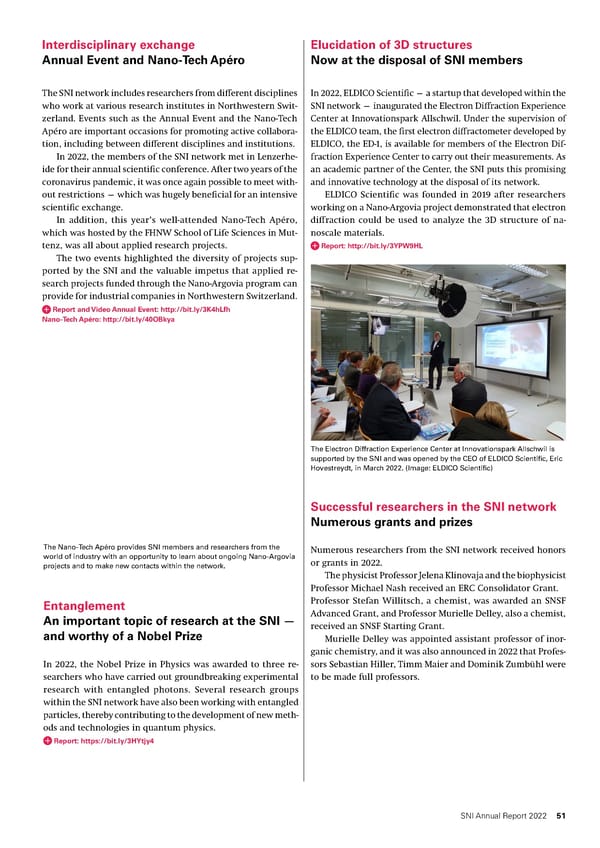
Communications and outreach: Educate and enthrall What actually are the nanosciences and why is it worth taking a clos- er look at this world of tiny structures? These are just two of the questions that the SNI communications and outreach team is always ready to answer. On visits to schools, at science festivals, at markets or at the museum, the SNI team has the opportunity to talk to a wide audience about these kind of questions, to provide people with infor- mation, and to share its fascination with and enthusiasm for the nat- ural sciences. These interactions work best in the form of exciting, small-scale ex- periments that encourage people to participate and reflect. Informa- tion about the various areas of the SNI’s work is also distributed in print materials, while electronic formats such as videos also provide information on the SNI’s various activities. At the same time, the SNI is reaching a growing audience through its various social media channels, whose followers now number over 4,300 people and organizations. Various channels blimärt in Aarau and informed people about the nanosciences Personal contact and interaction as part of the SamstagsUni course series offered by the VHSBB, via social media a Basel educational institution. Teaching staff and various school classes had the opportunity to familiarize themselves directly with examples of nanoresearch on visits to laboratories associ- In early 2022, one of the highlights for the SNI team was the ated with the SNI — or to perform fascinating experiments in inauguration of the special exhibition “Voller Energie” (Full of various subject areas as part of school visits or the Science Days Energy) at Museum Burghalde in Lenzburg. The SNI helped to at Europa-Park. make this exhibition such a huge success by setting up a water People with an interest in the SNI who were unable to find laboratory with various explanatory videos and by contributing out more at one of the numerous events could also access var- a chapter to the accompanying book. Subsequently, several ious social media channels. With this in mind, the SNI team workshops offered by the SNI team were a chance to demon- produced posts and videos on various subjects, including events, strate the special properties of water to elementary school pu- the course of studies, the PhD School and specific research top- pils with the help of various experiments. ics. In 2022, the SNI YouTube channel was visited over 110,000 During tunBasel, numerous children and young people vis- times — with the SNI videos clocking up a total viewing time ited the joint stand of the SNI and the Department of Physics, of 2,600 hours. where they could try their hand at making their own soaps as The SNI website represents another key source of informa- well as undertaking various soap-related experiments. tion. SNI staff spent the second half of the year working on a The second half of the year once again featured a busy cal- new website, which was launched in January 2023. In addition endar of events, offering ample opportunities to engage with a to redesigning the website, the SNI team also worked in collab- wide audience and inform them about the SNI’s activities. For oration with the agency STUDIO NEO to modernize and stream- example, the SNI team talked to numerous visitors at the Rüe- line the SNI logo and to give the print materials a fresh look. 52 SNI Annual Report 2022
Further informationen: YouTube channel: https://bit.ly/3u9XLjv LinkedIn: https://bit.ly/3rbYP4s Twitter: https://twitter.com/SNIunibas SNI web page: www.nanoscience.ch SNI webpage with experiments: http://bit.ly/3Hw1FIk Some of the events in summer focused on light — and above all UV light. These special UV beads offer an entertaining way of making ultraviolet rays visible. At other events, the SNI used glittering chocolate to attract visitors to the stand. This chocolate is stamped with a special microstructure while still be- ing semiliquid and therefore shimmers in bright colors without the need for dyes. For the water laboratory at the special exhibition “Voller Energie” (Full of Energy) at Museum Burghalde, the SNI team produced explanatory videos all about water. As well as information on the course of studies and the PhD School, the SNI team also produced videos about scientific topics. The new program at the TecDays invites learners to try their hand at experi- ments. Large crowds gathered at the SNI stand at tunBasel and the Science Days at Europa-Park. At the Rüeblimärt in Aarau, visitors big and small could win prizes if they answered a question about the nanosciences correctly. SNI Annual Report 2022 53
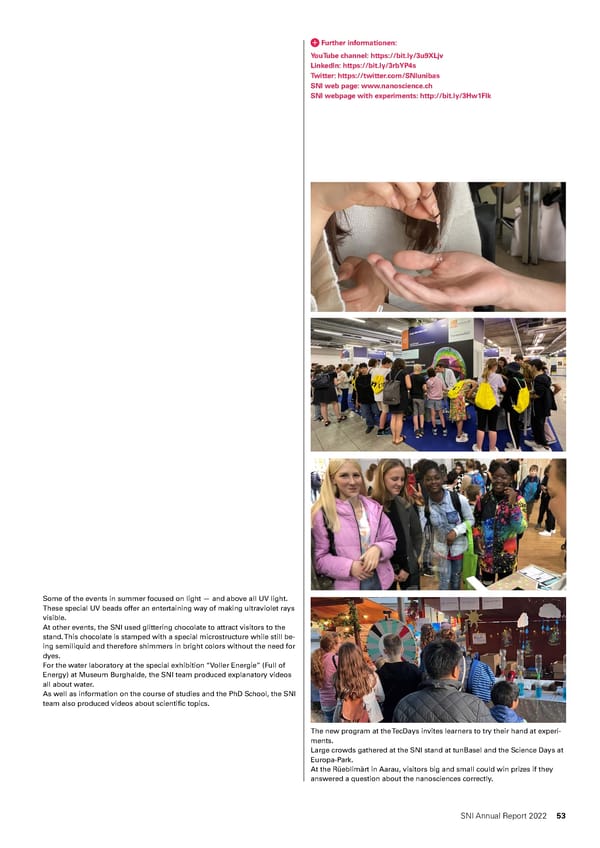
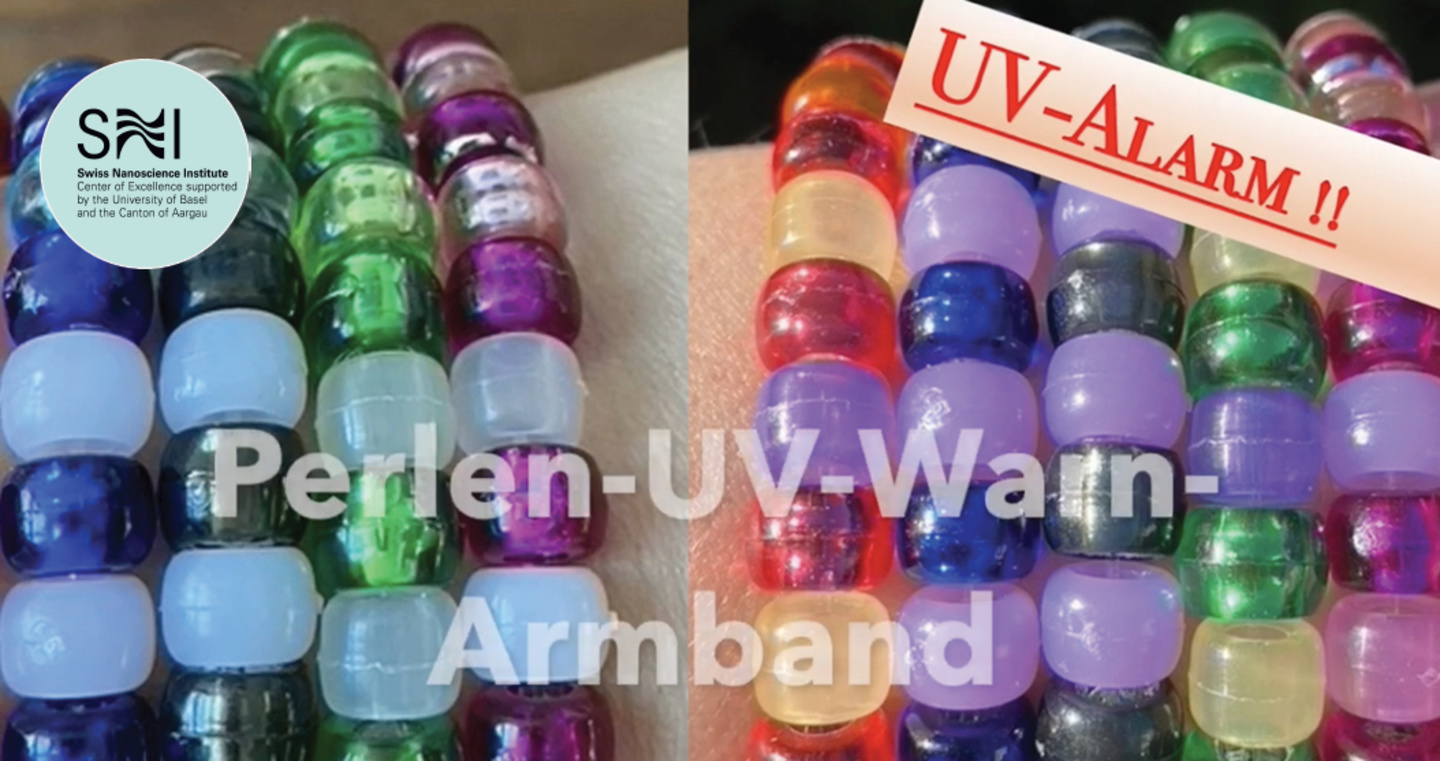
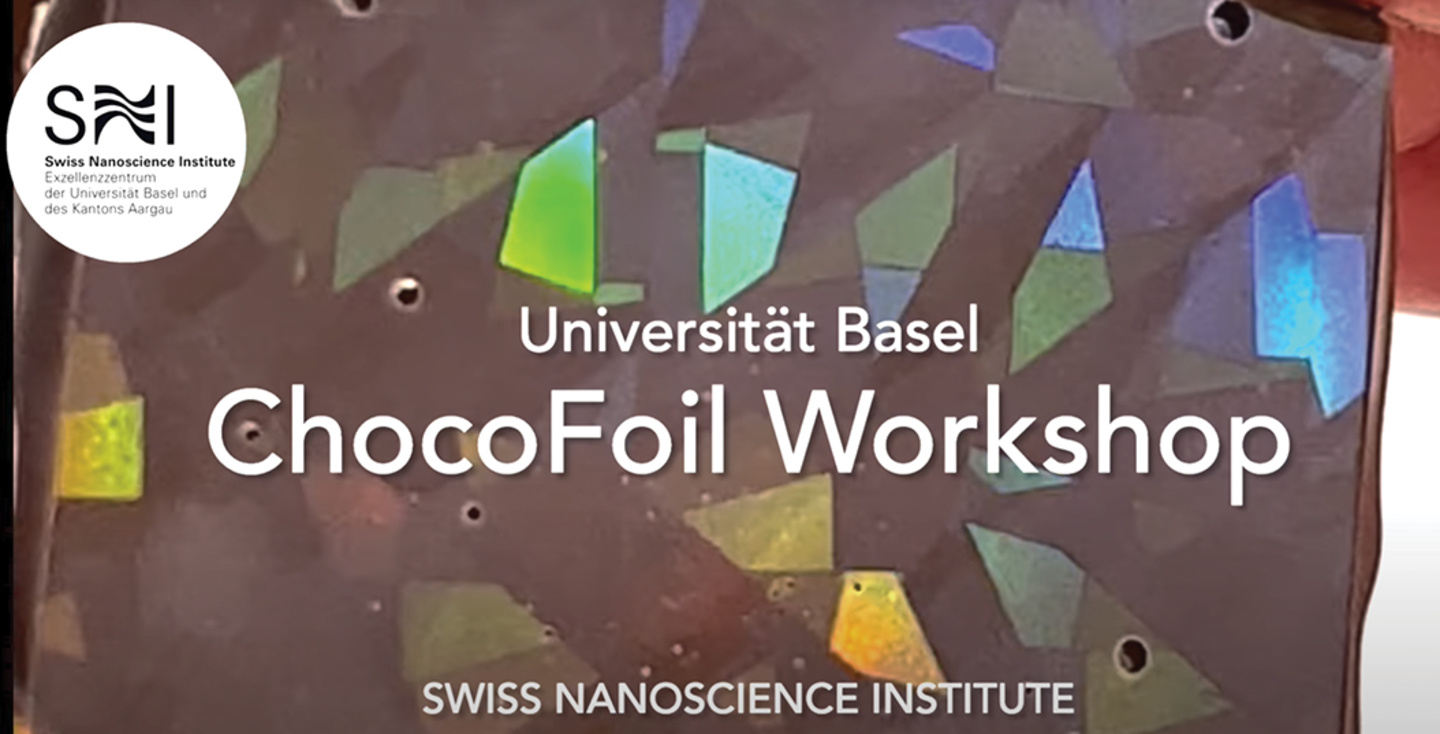
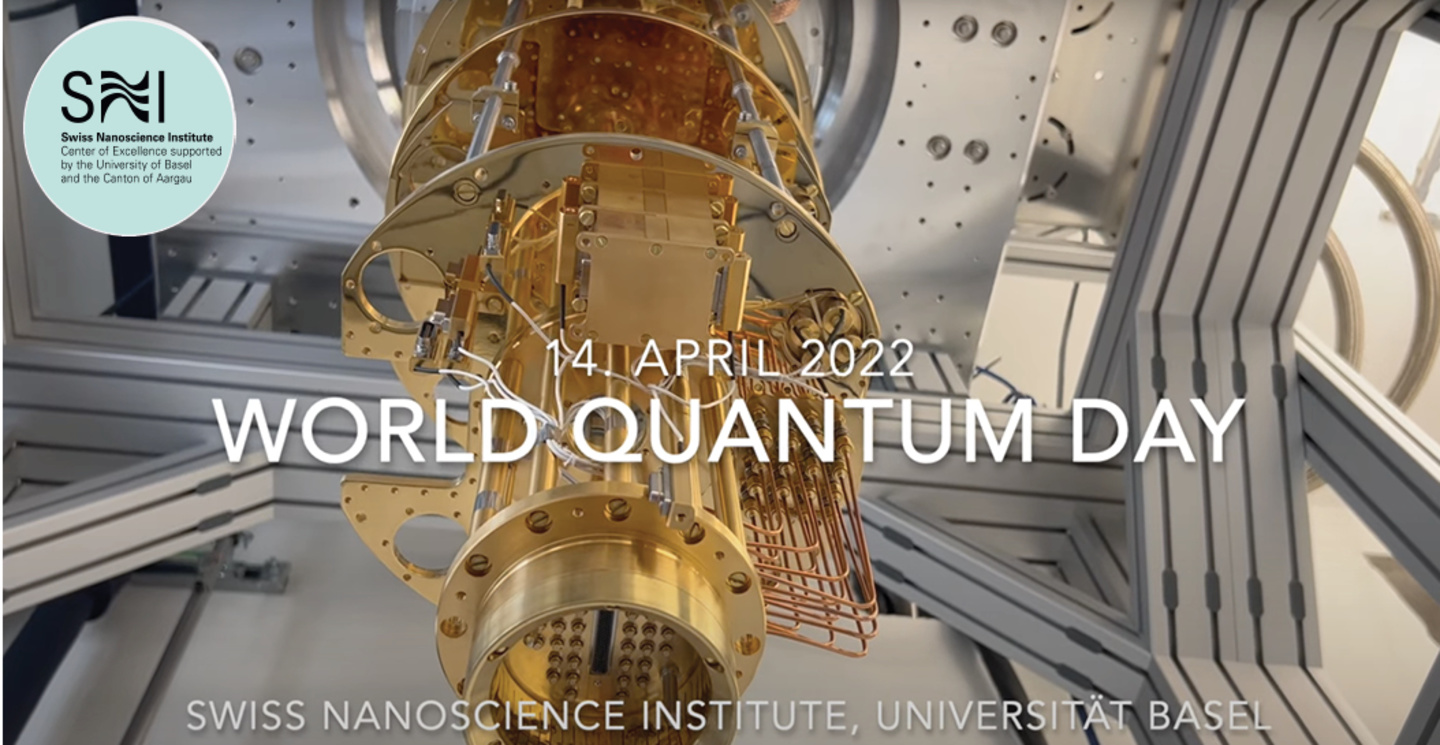
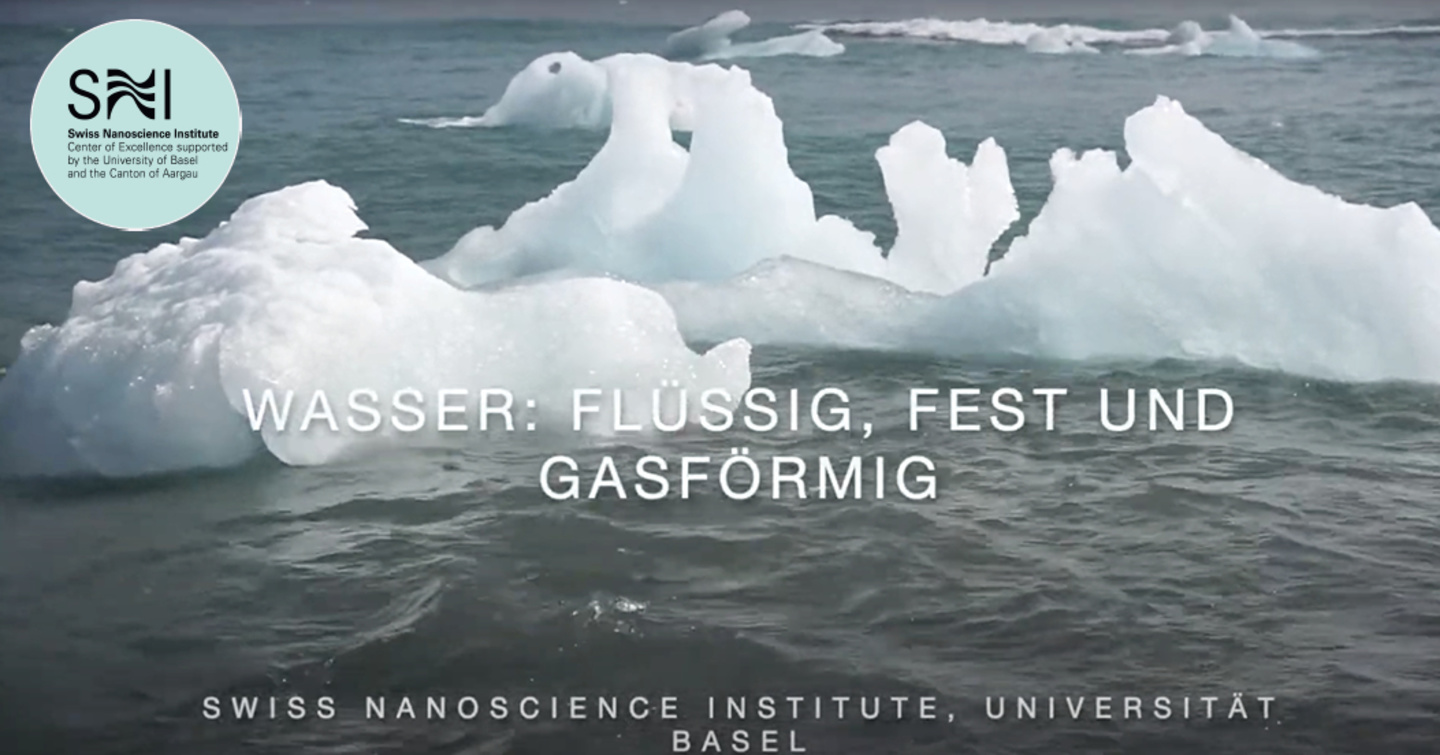
Financial report The Swiss Nanoscience Institute (SNI) was founded at the Uni- Nano-Argovia program supports technology transfer versity of Basel in 2006 on the initiative of the Canton of Aargau. With the Nano-Argovia program, which has existed since the Then, as now, the goal was to advance research in the nanosci- Swiss Nanoscience Institute was founded, the SNI supports ences, to support knowledge and technology transfer in North- knowledge and technology transfer to industry. The program western Switzerland, and to establish a center for the training sees companies from Northwestern Switzerland work with at of young scientists. These core aspects — teaching, basic and least two academic partners from the SNI network in order to applied research, as well as knowledge and technology transfer explore novel lines of research at an early stage. In 2022, four — are reflected in the SNI’s finances. new Nano-Argovia projects were launched, and eight projects from the previous year received an extension for a final year. Founded on basic research Six of the industrial partners are headquartered in the Canton At the SNI, basic research serves as the foundation for innova- of Aargau, while the other half of the companies come from tions. To this end, the SNI supports the work of the two Argovia one of the two Basel half cantons. Professors at the University of Basel, Roderick Lim and Martino The SNI’s entire budget for knowhow and technology trans- Poggio, as well as that of three titular professors at the PSI, fer was around CHF 1.4 million in 2022. Project partners con- Thomas Jung, Michel Kenzelmann and Frithjof Nolting. In total, tributed approximately CHF 1.1 million via public research fund- these professors received funding of some CHF 1.5 million in ing instruments (e.g. Innosuisse, the Swiss National Science 2022. Through their participation in national and international Foundation and EU funding) and funding from the research collaborations, the two Argovia Professors together secured an institutions themselves. The industrial partners contributed additional CHF 1.4 million in funding in 2022. This allows them around CHF 1.3 million to the various lines of research in the and their groups to conduct research at the highest level and, form of in-kind services. through their research findings, to make a significant contri- bution to the SNI’s excellent reputation. Nano Technology Center offers extended range of services Basic research is also the field in which most doctoral stu- The Nano Technology Center was founded in 2022 with a view dents work at the SNI PhD School, which was founded in 2012. to further expanding the SNI as a service center and establish- The 40 doctoral students who formed part of the PhD School ing the promising field of nanofabrication as a key pillar of the in 2022 conduct this research at various institutions within the SNI as well as professionalizing its work in this area. The Center SNI network — but they all earn their doctorates from the Fac- brings together the Nano Imaging Lab, which has formed part ulty of Science at the University of Basel. In total, the outgoings of the SNI since 2016, and the newly founded Nano Fabrication for the SNI PhD School ran to some CHF 1.8 million in 2022. Lab. With these two service units, the SNI is now in the position The following table shows expenses for 2022 by category in accordance with the financial report of the University of Basel dated 26 February 2023. Expenditure 2022 in CHF Univ. Basel Canton AG Total Management Personnel and operational costs 408,936 270,569 679,505 Overhead — 650,000 650,000 Infrastructure Infrastructure equipment 132,143 330,274 462,417 Personnel and operational costs 21,956 151,123 173,079 Knowhow & Techtransfer Nano-Argovia projects — 1,199,433 1,199,433 Personell and operational costs 93,088 96,791 189,879 Outreach & PR Argovia professorships 516,727 1,006,773 1,523,500 Support PSI professors 57,585 57,585 Nano Curriculum Bachelor and master programs 313,743 234,266 548,009 Nanotechnology Center Nano Imaging/Nano Fabrication 652,566 161,103 813,669 SNI PhD School Personnel and operational costs 803,132 981,605 1,784,737 Total expenditure 2022 in CHF 2,942,292 5,139,523 8,081,815 54 SNI Annual Report 2022
to provide customers from industry and academia with com- Investments in the future prehensive services in the area of imaging as well as in micro With a view to driving further advances in nanoscience research and nano fabrication. The investments needed to build up these in the region, the SNI also invested in various projects in 2022 services are largely funded from the SNI’s reserves. Although — including the Electron Diffraction Experience Center, for the necessary orders were made in 2022, delivery problems have example, which was inaugurated in 2022 and provides the SNI meant that investments of some CHF 0.9 million will only ap- with services for its network. Further investments relate to the pear in the 2023 financial report. In total, the budget of the ANAXAM technology transfer center, of which the SNI is a Nano Technology Center ran to CHF 0.8 million. So far, some founding member, and a collaboration with the Paul Scherrer CHF 0.5 million have been invested in new infrastructure. Institute PSI. Here, the SNI is involved in the realization and commissioning of an experimental station (SOPHIE), which al- Study and outreach lows experiments to be carried out at the Swiss Synchrotron Since the SNI was founded, one of its key objectives has been Light Source. to train outstanding early career researchers so that they have In the last line of the balance sheet, some CHF 6.6 million a broad grounding in the natural sciences and can engage in are shown as “SNI assets per 31/12/2022 in CHF.” However, most interdisciplinary work on various topics in the nanoworld. With of this money has already been committed. Some CHF 1 million this in mind, the University of Basel is the only Swiss university have already been committed in previous years, but have not to offer a bachelor’s and master’s degree program in the nano- yet been invoiced, including equipment for the Nano Technol- sciences. In 2022, there were a total of 84 students enrolled on ogy Center. This balance also includes funds allocated to indi- the nanoscience program (59 on the bachelor’s and 25 on the vidual Nano-Argovia projects that have not yet been spent, as master’s degree course). The SNI contributed some CHF 0.5 mil- well as reserves used to guarantee a full 48-months of funding lion to the program’s costs. for all doctoral students currently enrolled in the SNI PhD To raise awareness of these unique and demanding degree school. courses, the SNI team participates in various events. It is also We would like to extend our sincere thanks to the Finance important for the SNI to provide broad sections of the popula- department at the University of Basel for its efficient financial tion with information about the nanosciences, their possible reporting. Thanks are also due to the Cantons of Aargau, Ba- applications and the Canton of Aargau’s commitment to this sel-Stadt and Baselland for their long-standing and loyal support field. In addition, the SNI shares news on social media and uses of the SNI. Their commitment makes it possible for us to train print materials to inform the public about its various activities. excellent young researchers, obtain new scientific insights and In terms of the SNI network, key activities also include internal collaborate with companies on innovative projects as we work events such as the Annual Event or networking opportunities toward building a better future. such as the Nano-Tech Apéro. In 2022, the outgoings for activi- ties of this kind came to about CHF 0.2 million. The following table shows the SNI balance sheet as of 31 December 2022: SNI balance sheet 2022 in CHF Univ. Basel Canton AG Total Grants Investment income 2,660,800 5,000,000 7,660,800 ( 7,139) 7,736 597 Income 2,653,661 5,007,736 7,661,397 Expenditure 2,942,292 5,139,523 8,081,815 Balance year 2022 (288,631) (131,787) (420,418) SNI assets per 01/01/2022 1,992,975 5,055,548 7,048,523 Annual balance (288,631) (131,787) (420,418) SNI assets per 31/12/2022 in CHF 1,704,344 4,923,761 6,628,105 SNI Annual Report 2022 55
Nano Imaging Lab Organization Dr. M. Dürrenberger (Head) Dr. M. Wyss (Deputy head, TEM, FIB-SEM) E. Bieler (SEM) Argovia Board S. Erpel (SEM, TEM) Landammann A. Hürzeler, Head Department of Education, D. Mathys (FIB-SEM, image coloring) Culture and Sport, Canton of Aargau Dr. M. Schönenberger (AFM, LSM) Prof. Dr. C. Bergamaschi, President FHNW Prof. Dr. C. Rüegg, Director Paul Scherrer Institute Prof. Dr. A. Schenker-Wicki, President University of Basel Prof. Dr. C. Schönenberger, Director SNI (until 31 July 2022) Nano Fabrication Lab Prof. Dr. M. Poggio, Director SNI (since 01 August 2022) Dr. Gerard Gadea (Head) Prof. Dr. G.-L. Bona, Director Empa Arnold Lücke (financed by the Department of Physics) Dr. W. Riess, IBM Department Head & Coordinator Binnig & Rohrer Nanotechnology Center SNI Executive Board (until 31 July 2022) Lists of members and Prof. Dr. C. Schönenberger, Director SNI (Nanocurriculum) Prof. Dr. P. M. Kristiansen, Vice Director (Network) projects 2022 Prof. Dr. D. Loss, Vice Director (Theoretical Physics) Prof. Dr. E. Meyer, Vice Director (Experimental Physics) Prof. Dr. M. Poggio, Vice Director (ANAXAM & Experimental Principal Investigators and associated members Physics) https://bit.ly/3lGLCAk Prof. Dr. A. Schier, Vice Director (Biozentrum) Prof. Dr. T. Schwede, Vice Director (President’s Office) PhD students https://bit.ly/3EbvZHv SNI PhD School projects 2022 SNI Executive Board (since 01 August 2022) https://bit.ly/3YsHcvn Prof. Dr. M. Poggio, Director SNI (PhD School) Prof. Dr. M. Maletinsky, Vice Director (Nano-Argovia program) Nano-Argovia projects 2022 Prof. Dr. J. Huwyler (Nano Curriculum, Departement of Phar- https://bit.ly/3YWNqDs maceutcial Sciences) Prof. Dr. R. Y. H. Lim (Biozentrum) Prof. Dr. K. Moselund (Paul Scherrer Institute) Prof. Dr. T. Schwede (President’s Office) Prof. Dr. O. Tagit (University of Applied Sciences Northwestern Switzerland) Further information Prof. Dr. O. Wenger (Department of Chemistry) C. Wirth, SNI General Manager (HR, Finance, Administration) Prof. Dr. I. Zardo (Nano Technology Center, Department of Physics) If you would like to know more about the Swiss Nanoscience Institute, please visit our website (www.nanoscience.ch) or fol- low us on LinkedIn, Twitter or YouTube. There we regularly post news from the network. SNI Management C. Wirth, General Manager (HR, Finance, Administration) Scientific supplement Dr. A. Baumgartner (PhD School) Scientific reports from all the Nano-Argovia and SNI PhD School Dr. A. Car (Coordination Nano Curriculum) projects from 2022 can be found on our website or by scanning S. Chambers (Coordination Nano Curriculum) the QR code. Dr. K. Beyer-Hans (Communications, outreach) http://bit.ly/3Y5fVht S. Hüni (Communications, outreach) Dr. C. Möller (Communications, media contact, social media) Dr. M. Wegmann (Communications, outreach, social media) 56 SNI Annual Report 2022
Cover image: Analysis of human cells expressing a red fluorescent transgene by confocal microscopy. Cells were transfected using a lipid-nanoparticle (LNP) based gene delivery system. Bright green signal: endosomal escape, green signal: Galectin3-GFP, red signal: transgene RFP,- cyan signal: cell nuclei, blue signal: LNP (Image: Claudio Alter, Department of Pharmaceu- tical Sciences, University of Basel) About this publication: Design concept: STUDIO NEO Text and layout: C. Möller and M. Poggio with support by PIs and PhD students Translations and proof-reading: UNIWORKS (Erlangen, Germany) Images: If not referenced C. Möller © Swiss Nanoscience Institute, March 2023 SNI Annual Report 2022 57
Educating Talents since 1460. University of Basel Swiss Nanoscience Institute Scientific supplement Petersplatz 1 University of Basel P.O. Box Klingelbergstrasse 82 4001 Basel 4056 Basel Switzerland Switzerland www.unibas.ch www.nanoscience.ch

